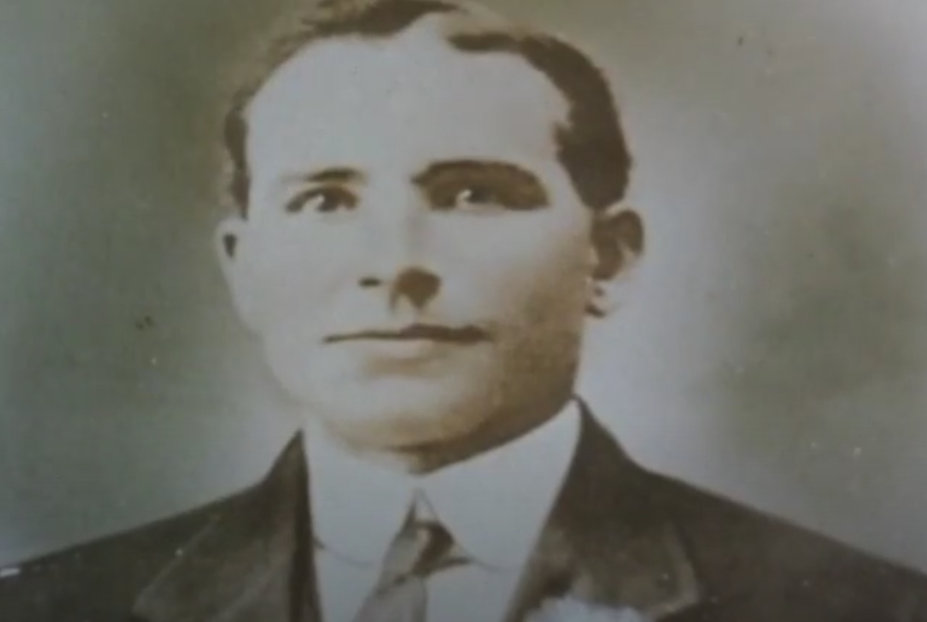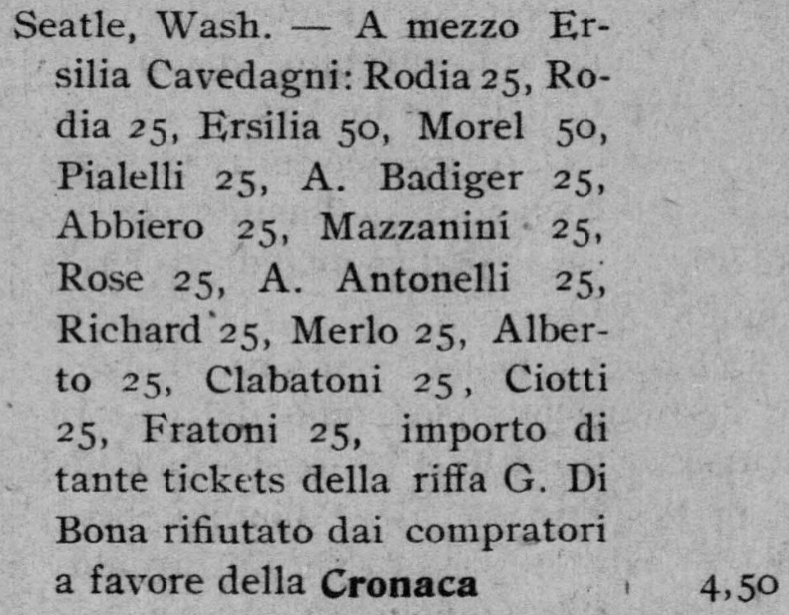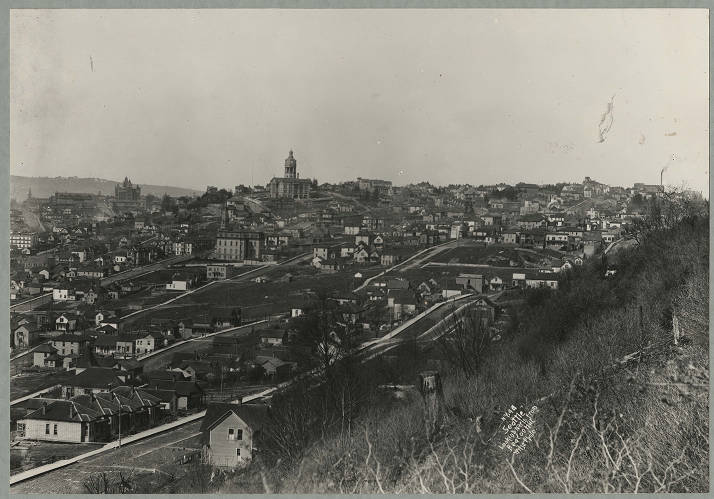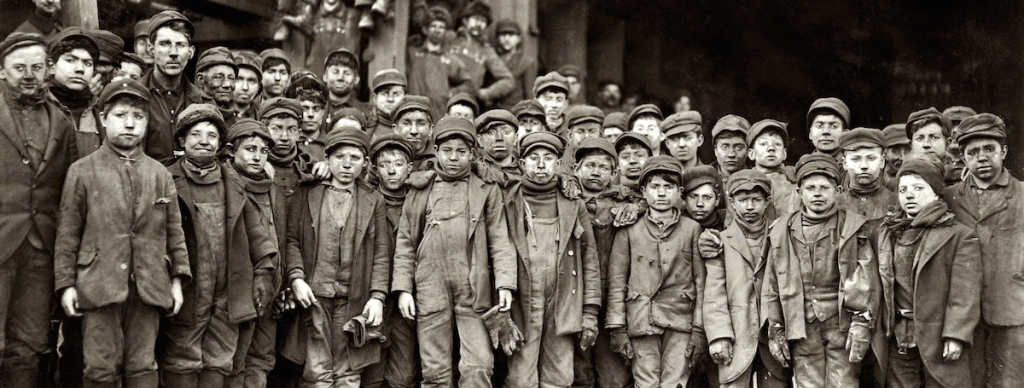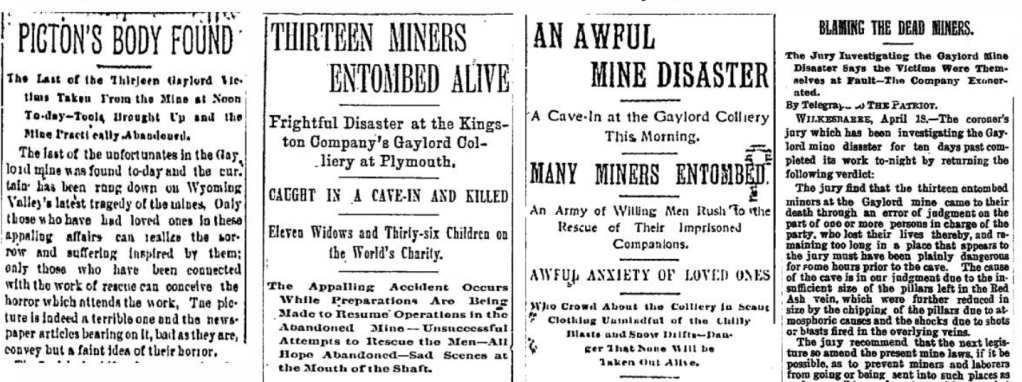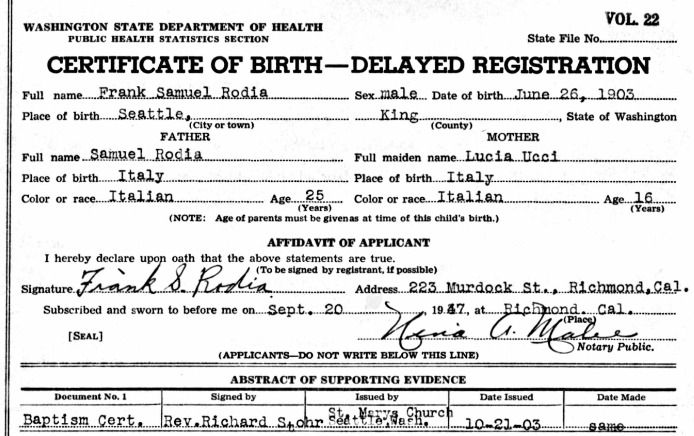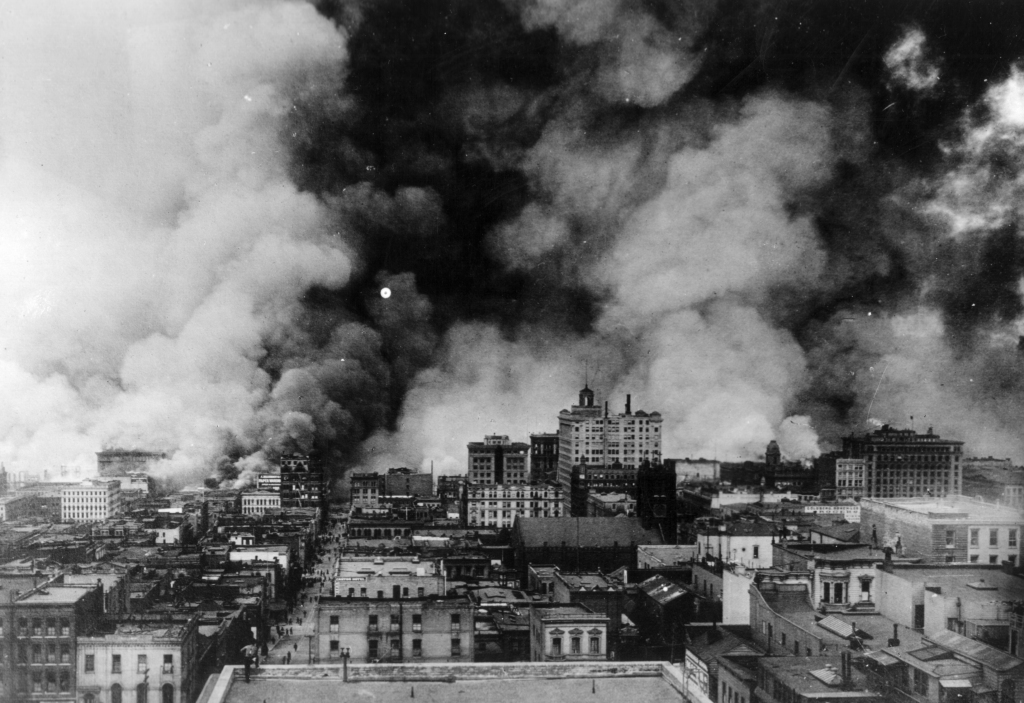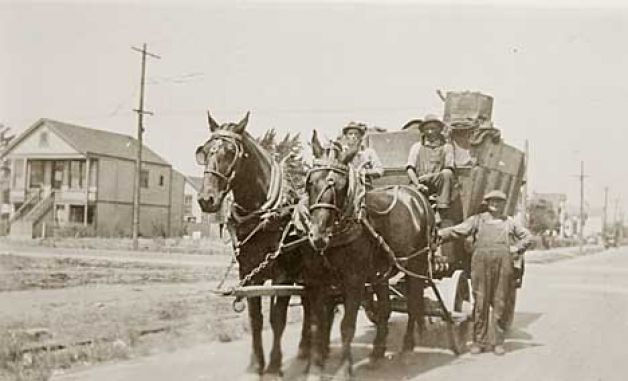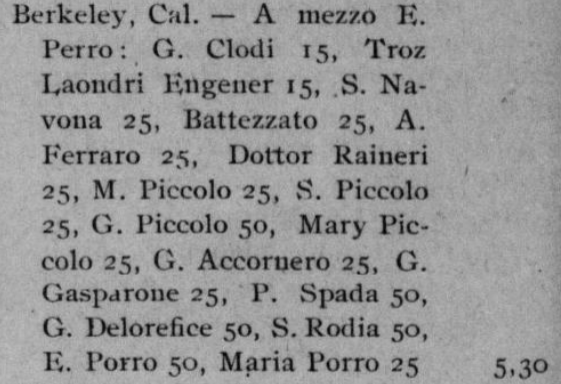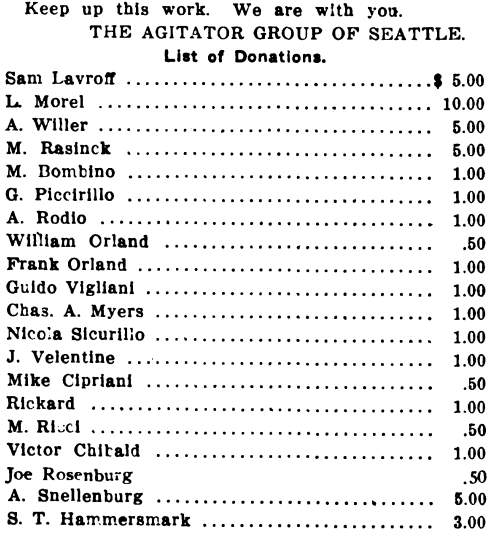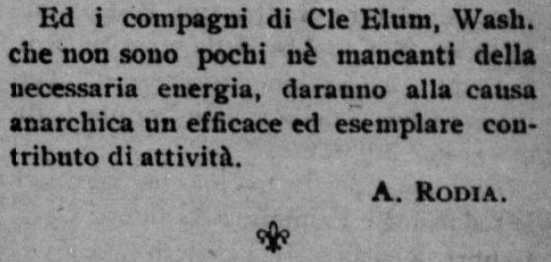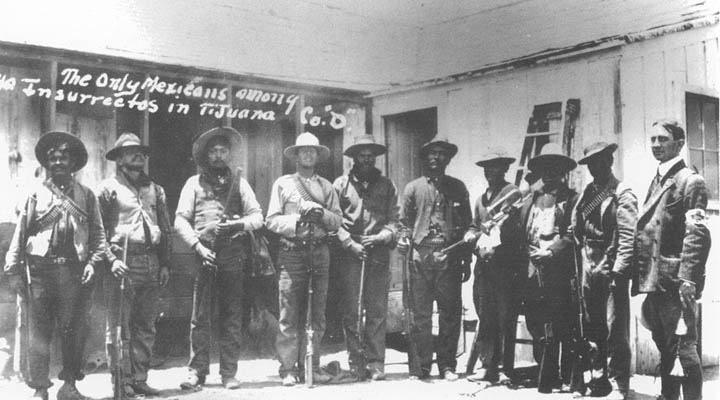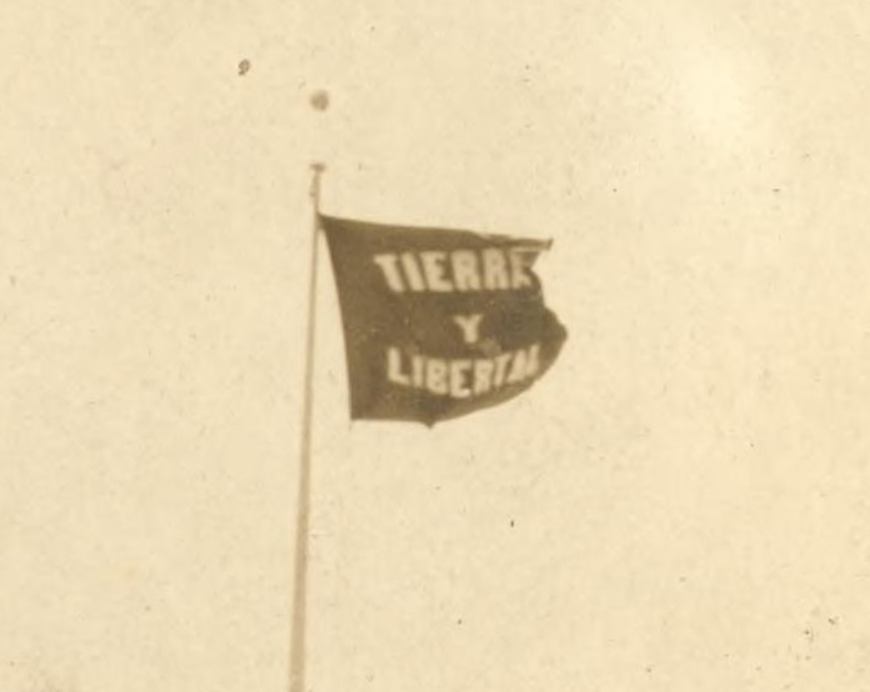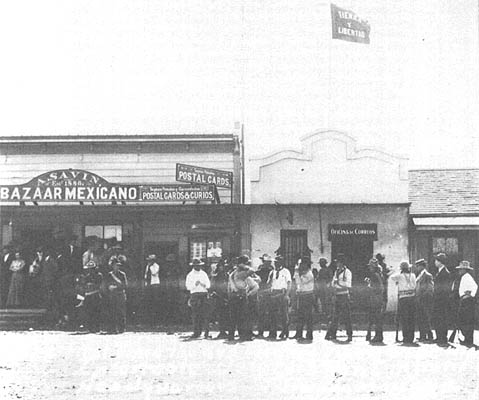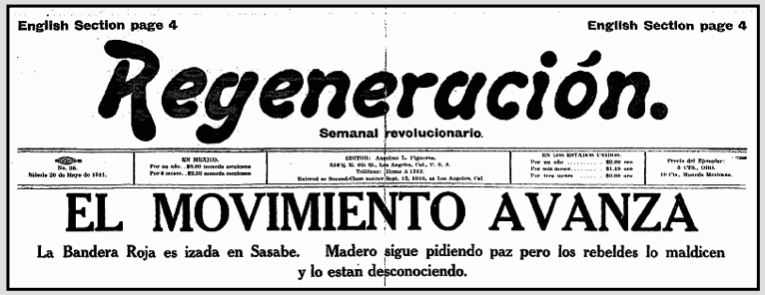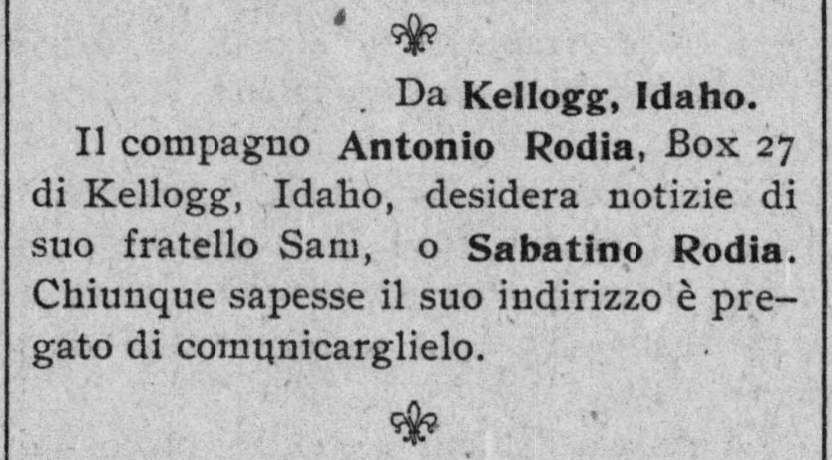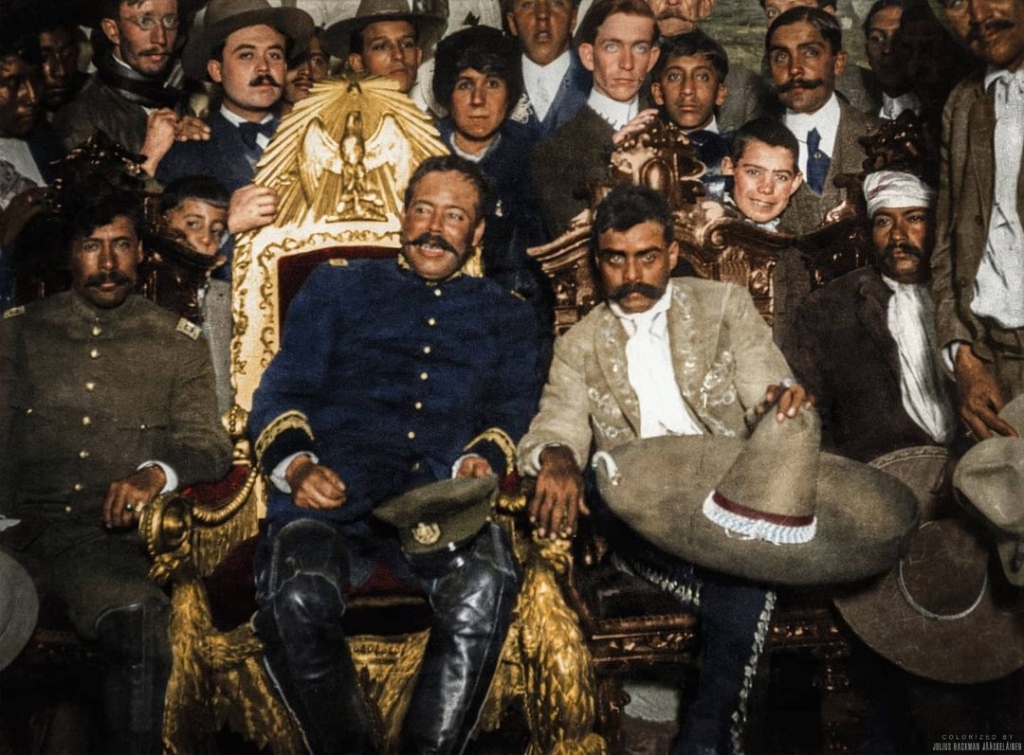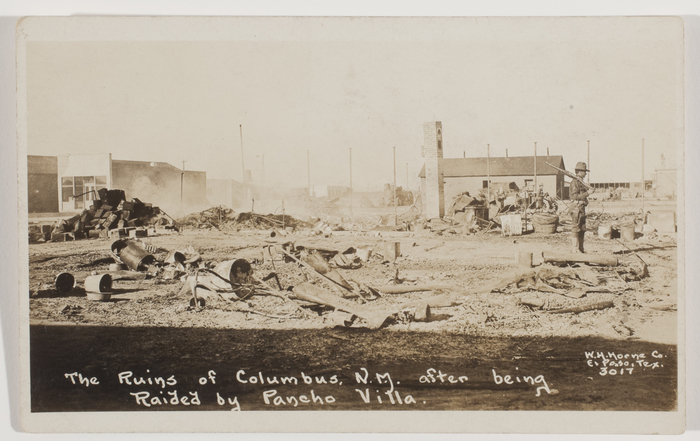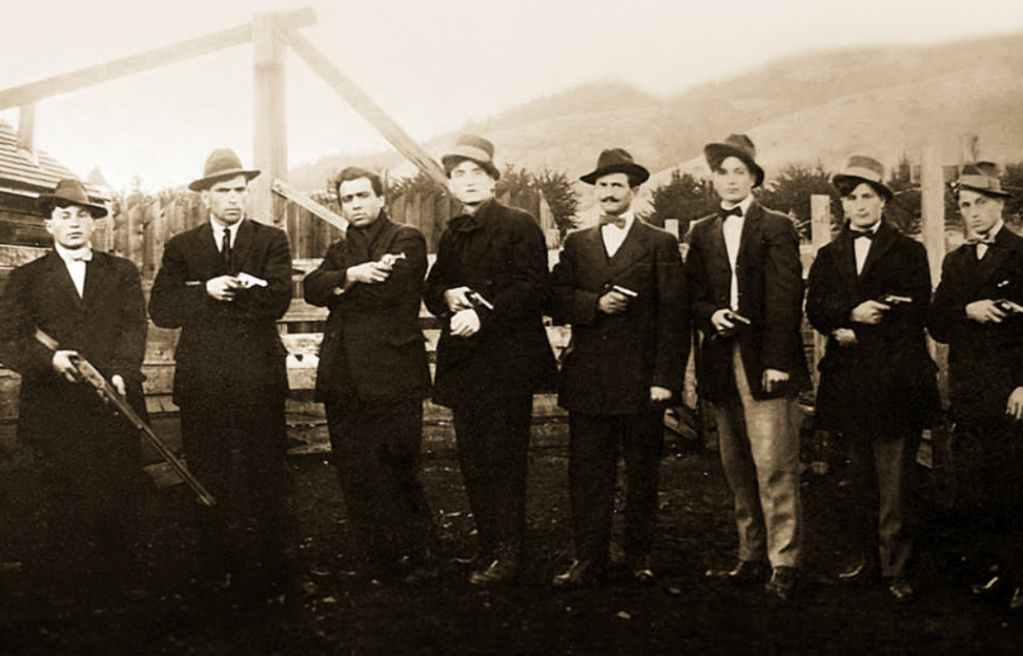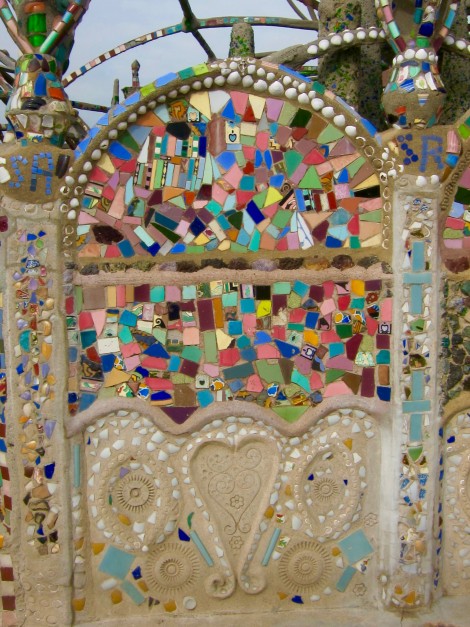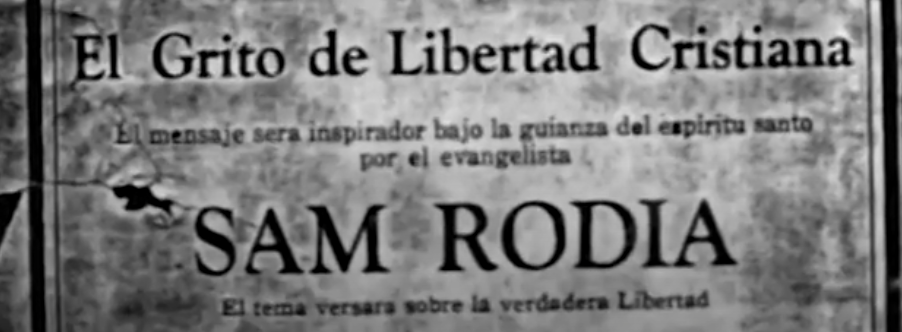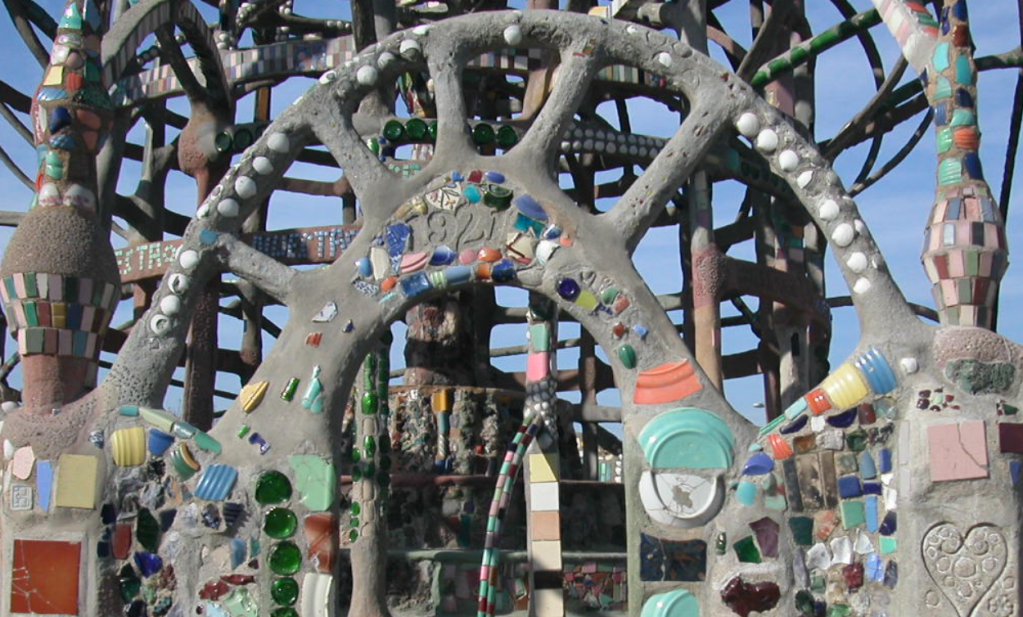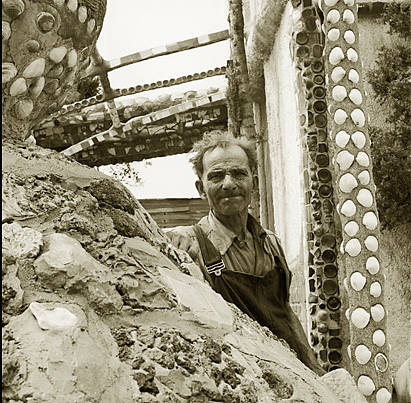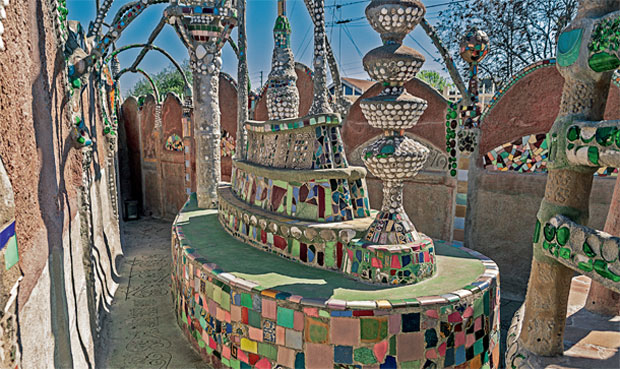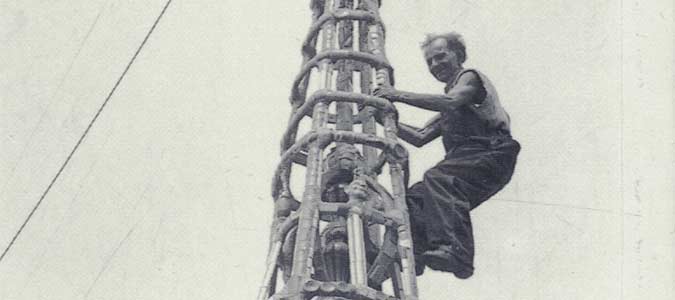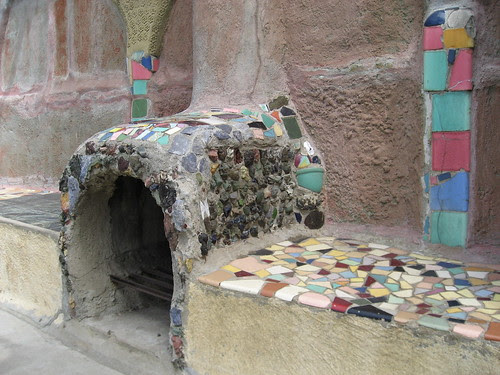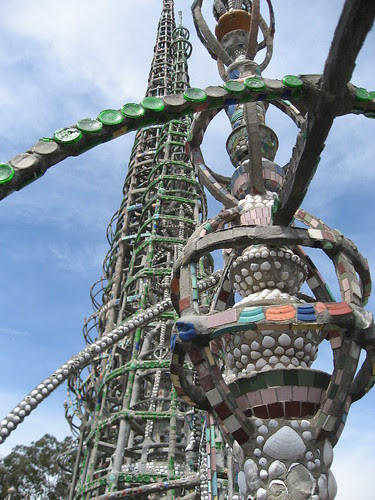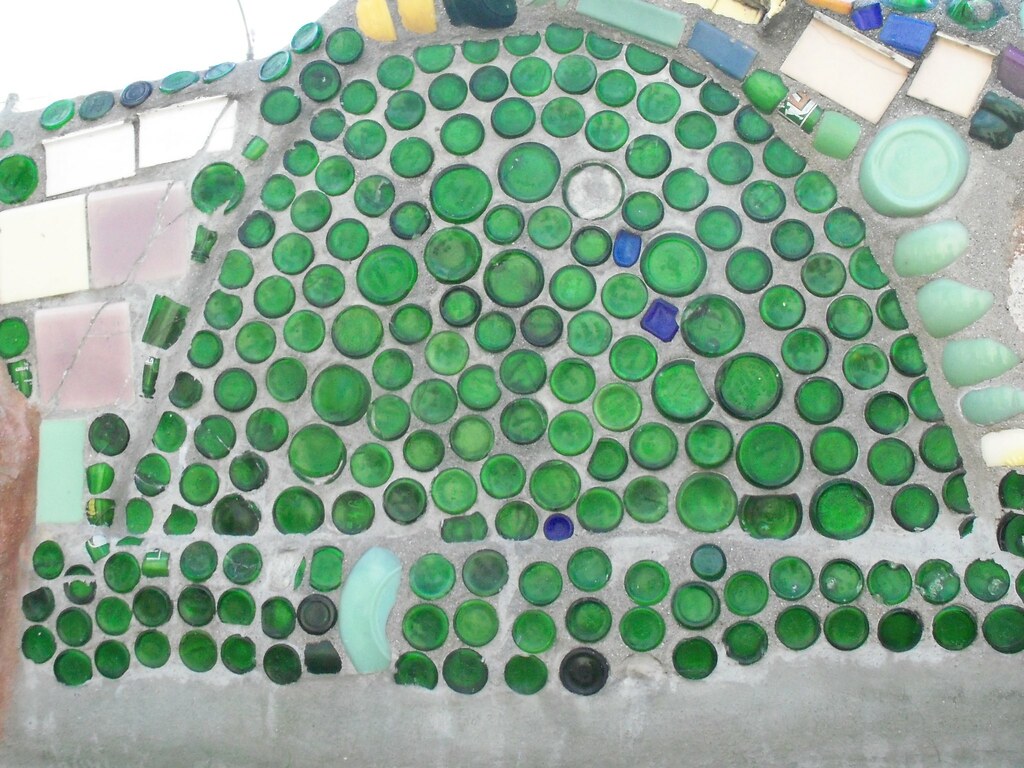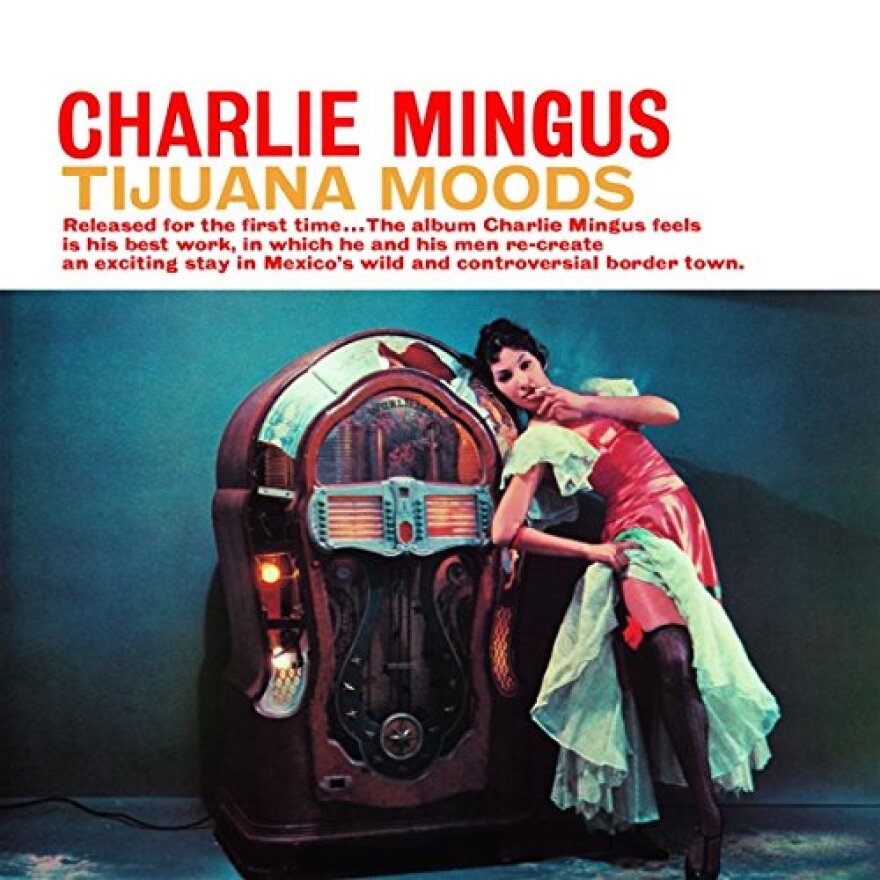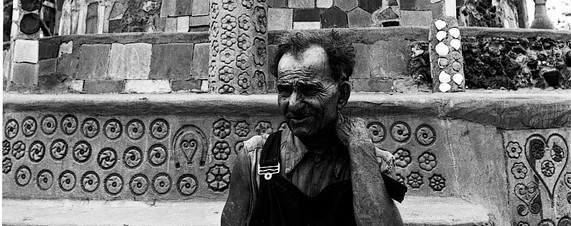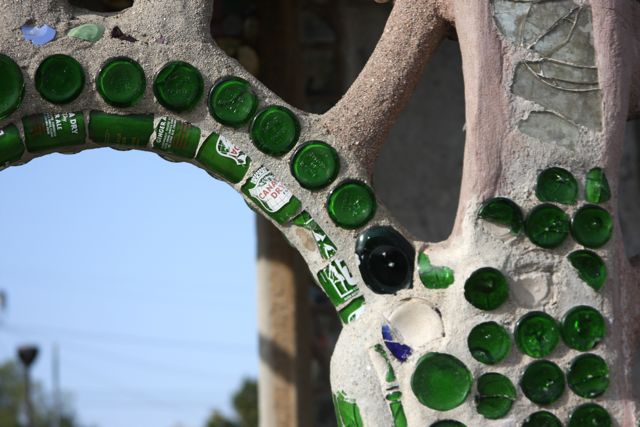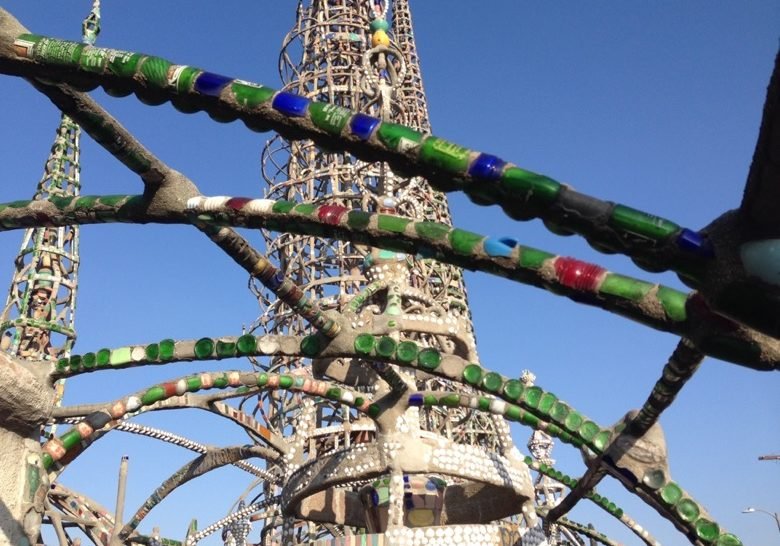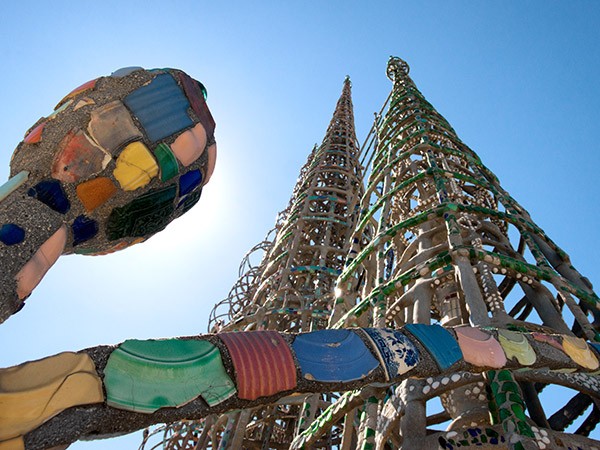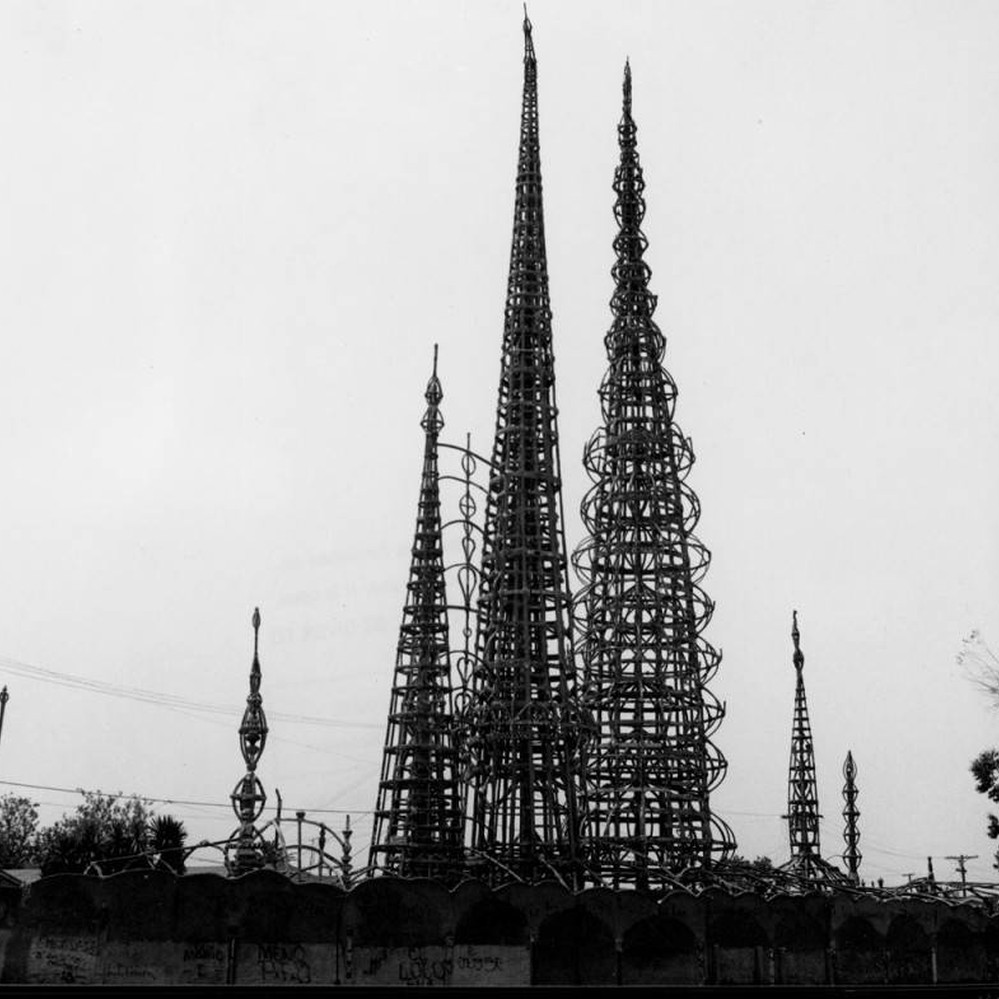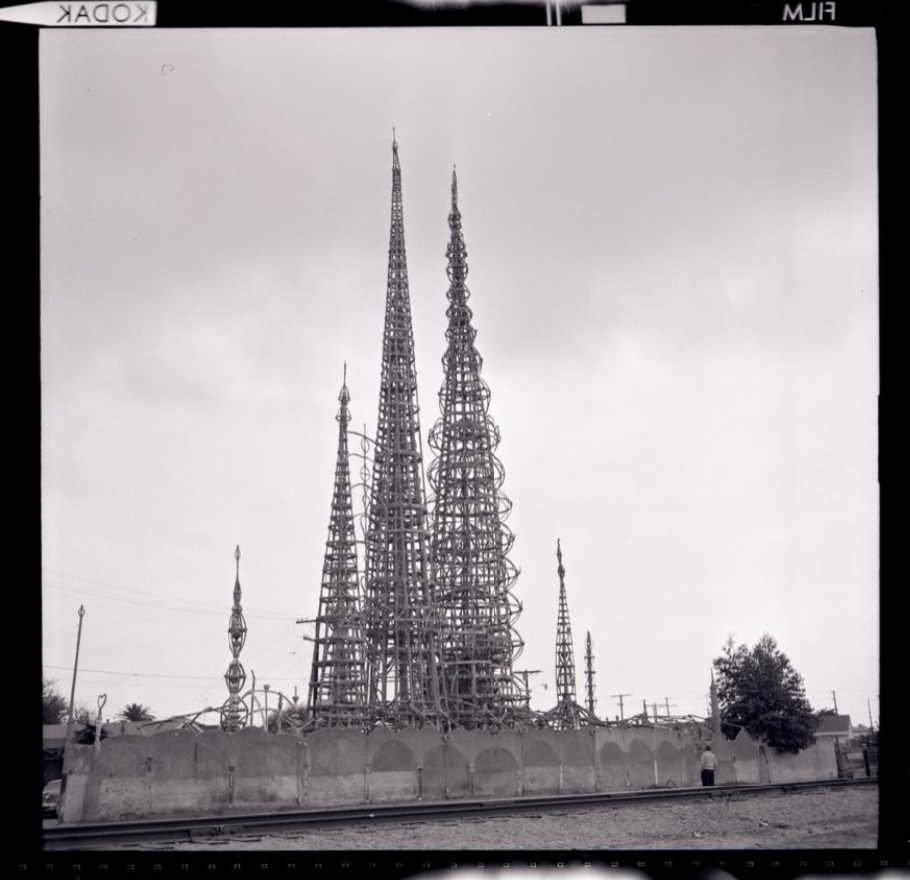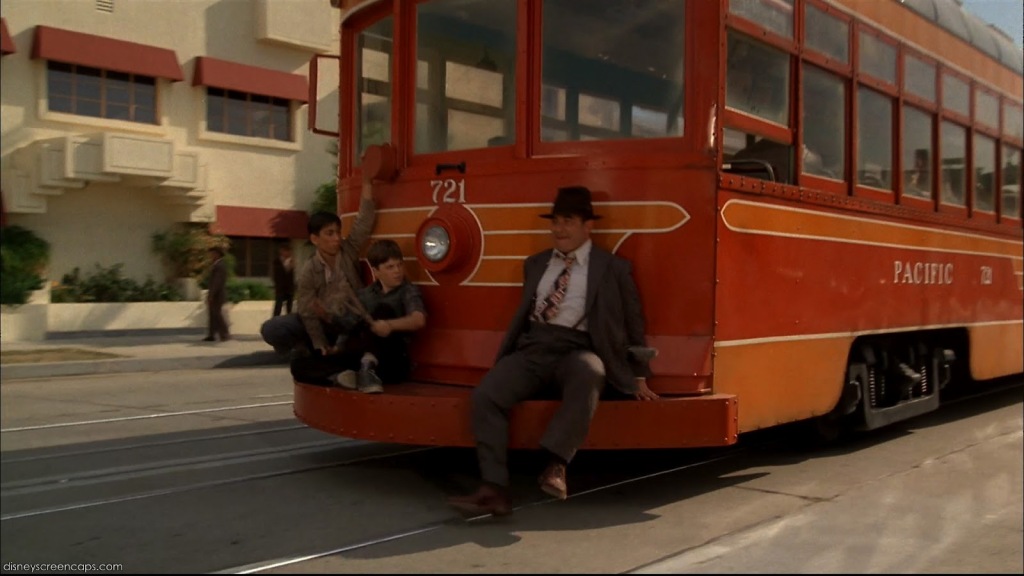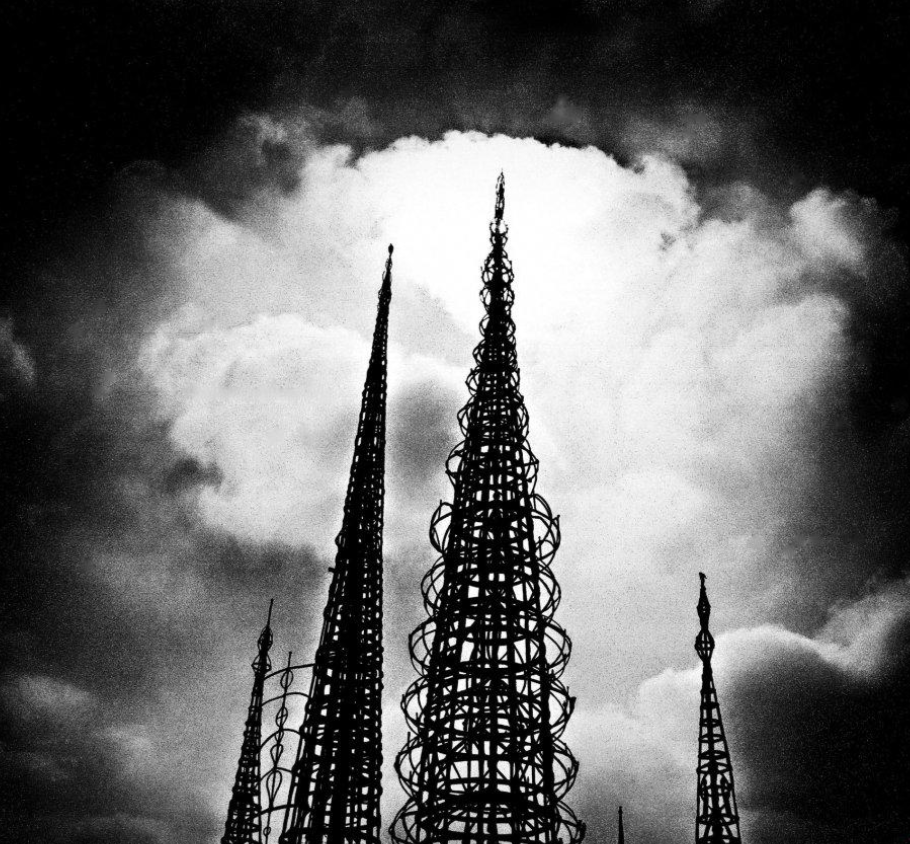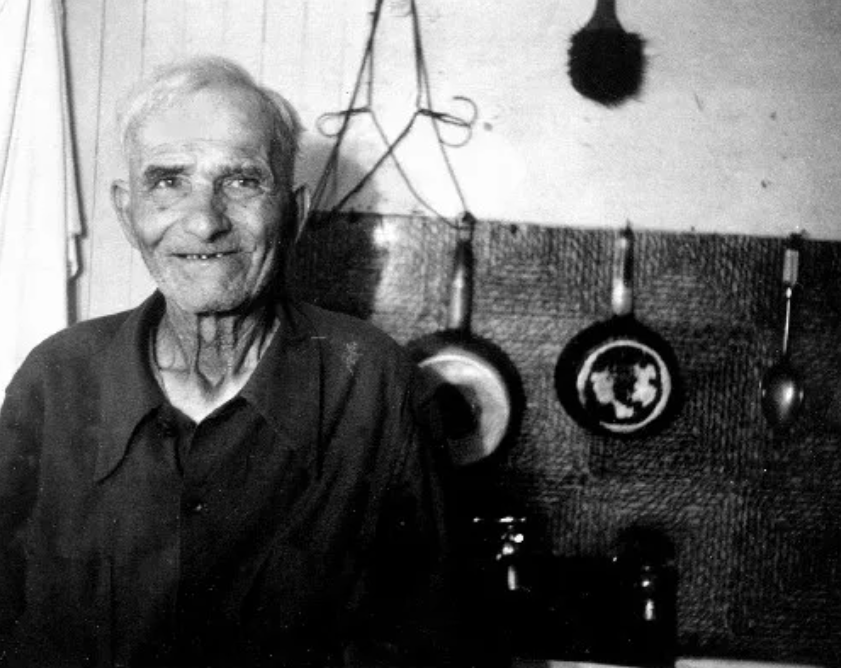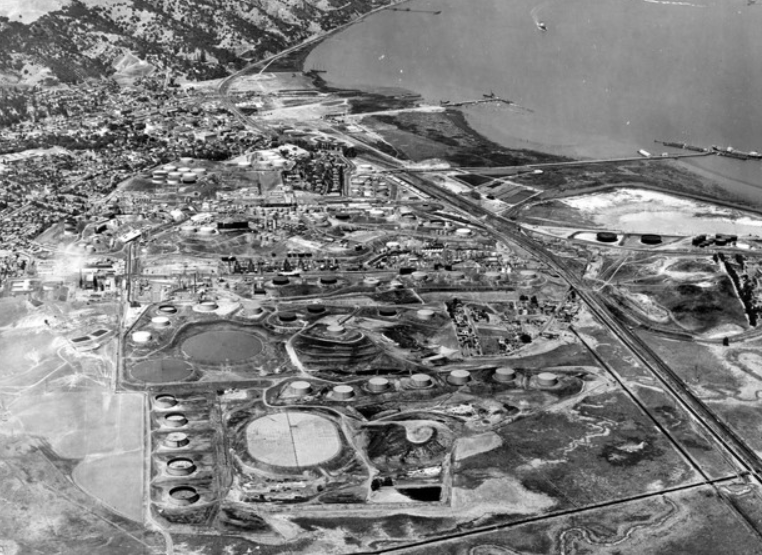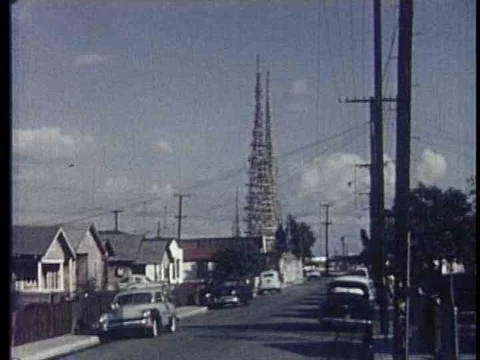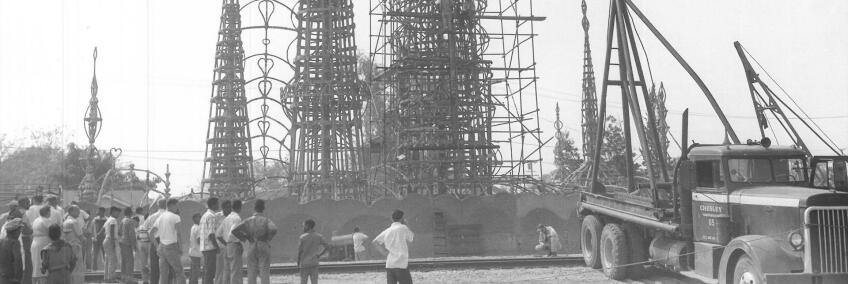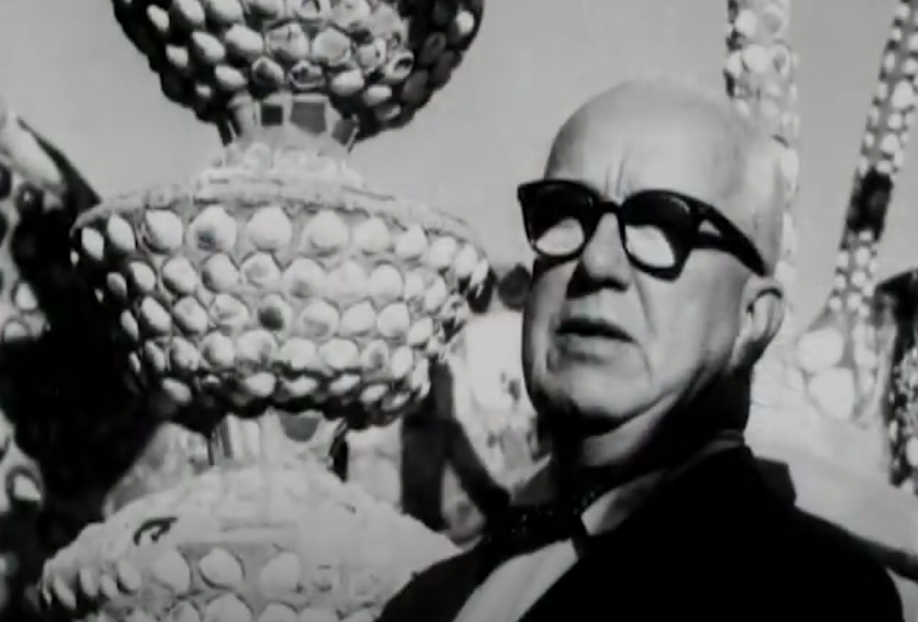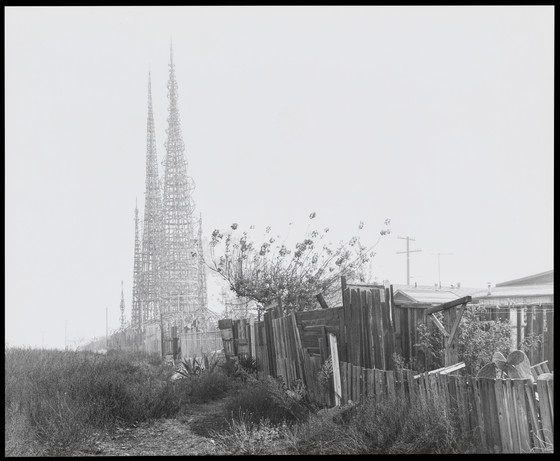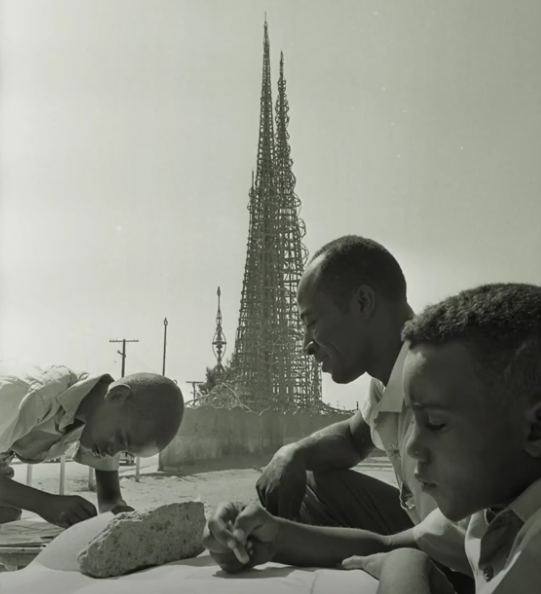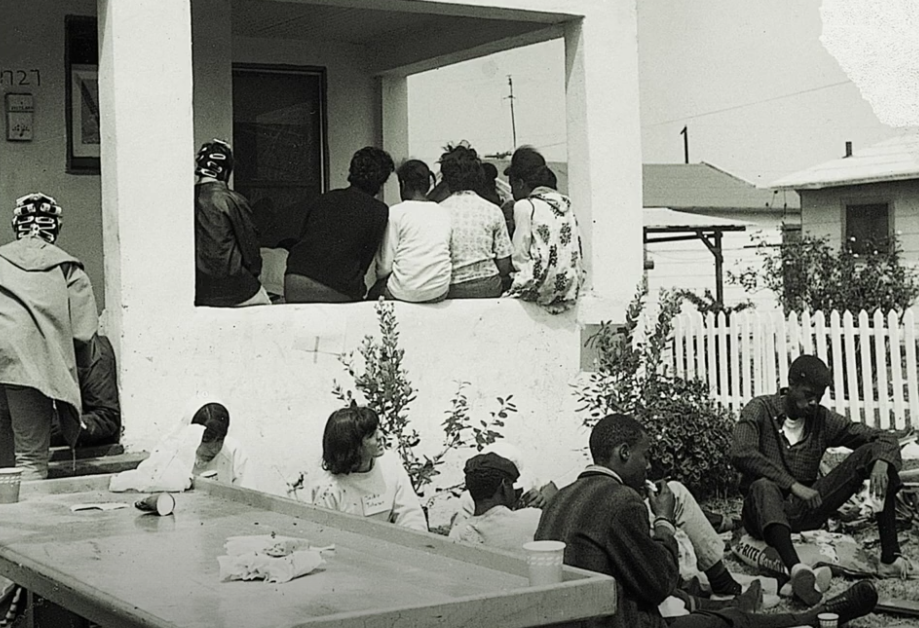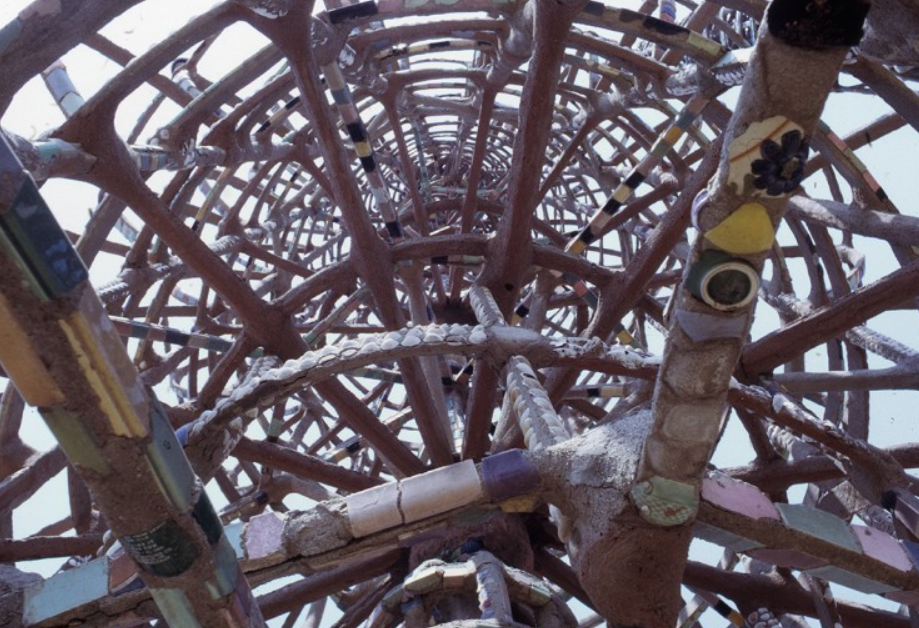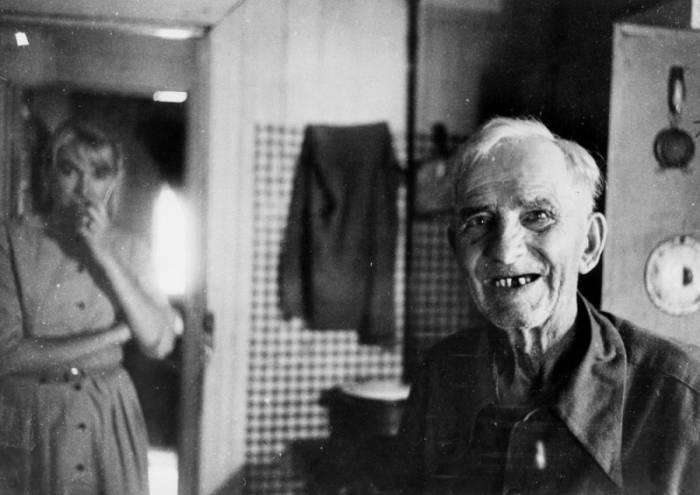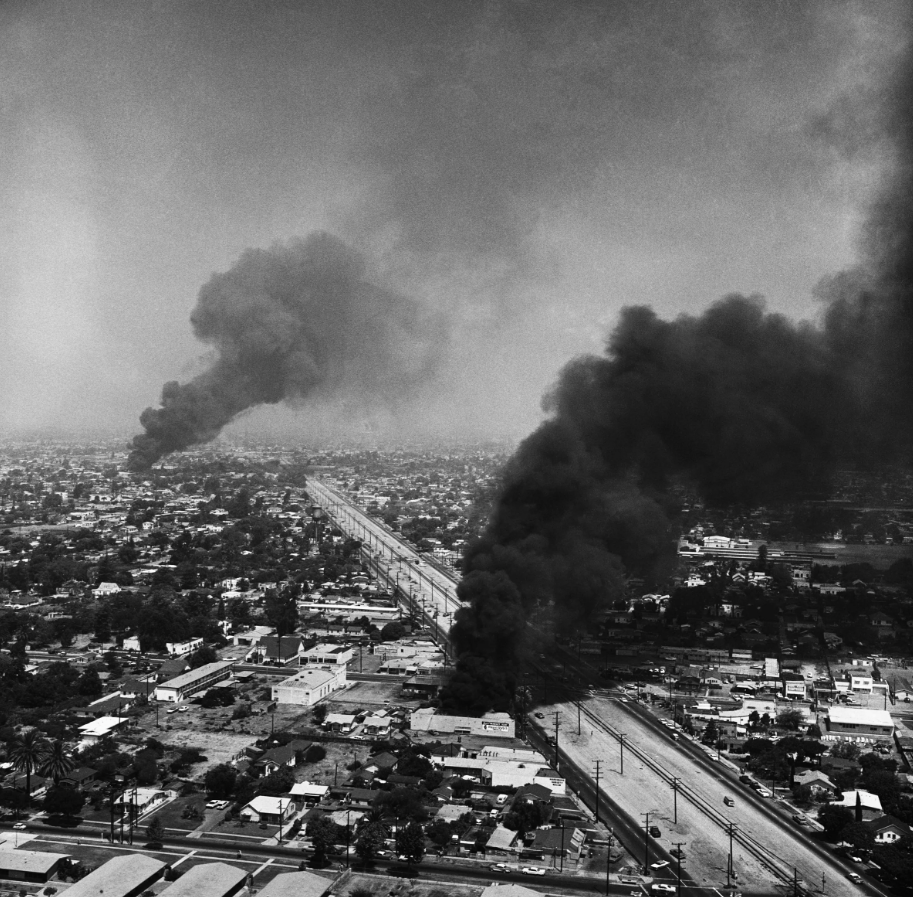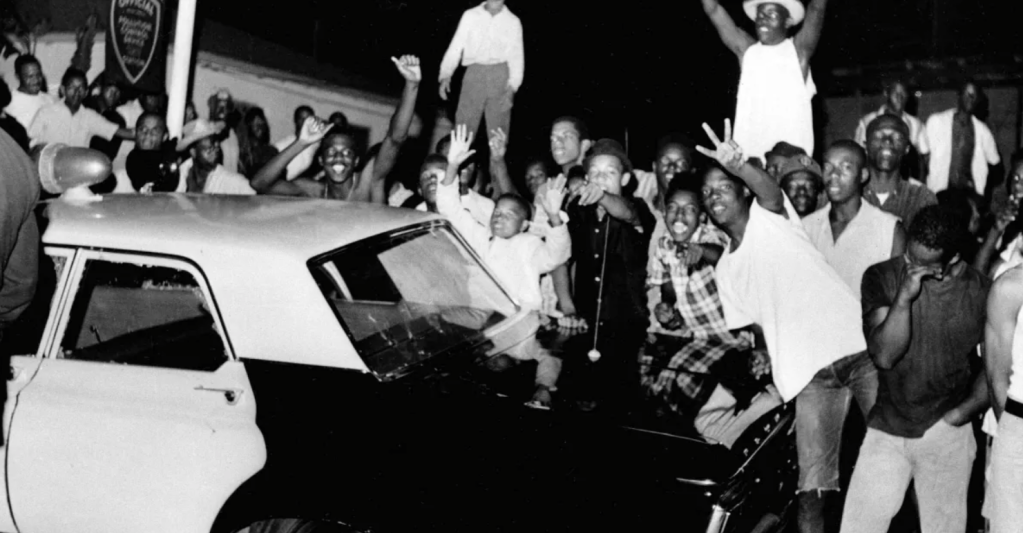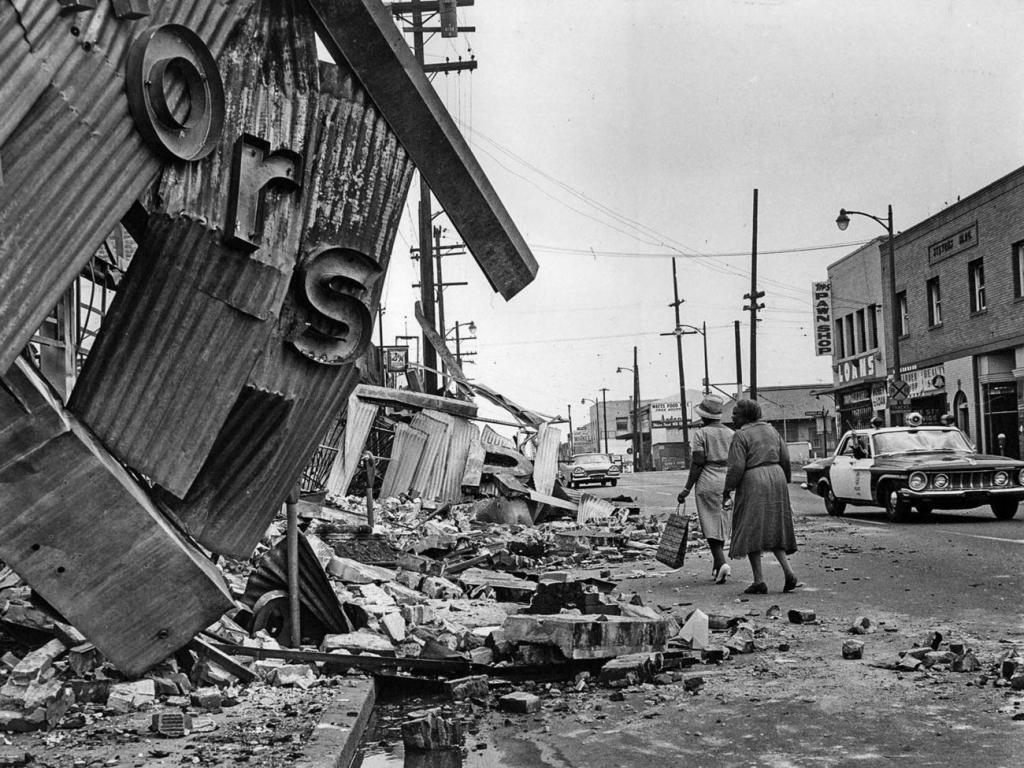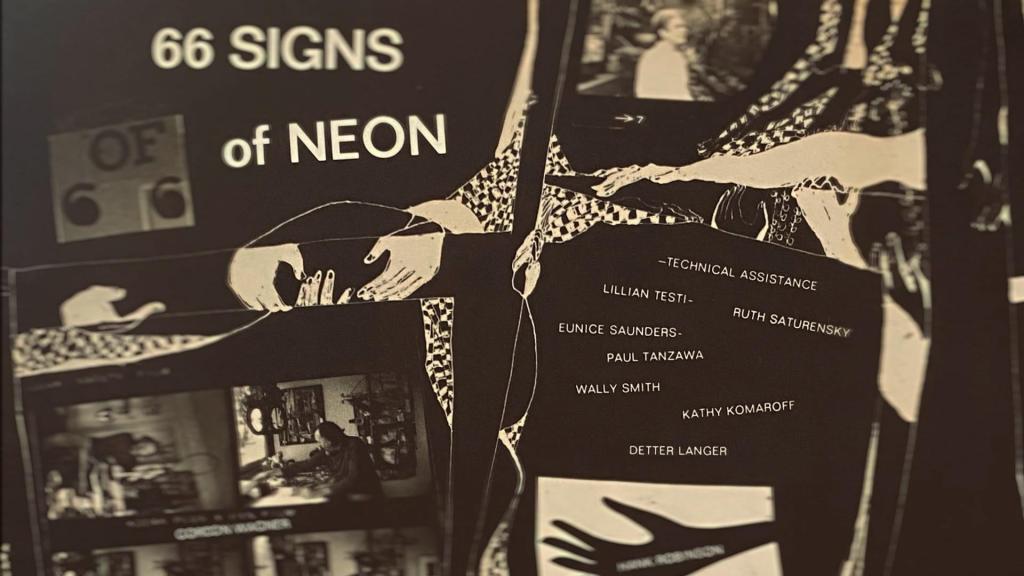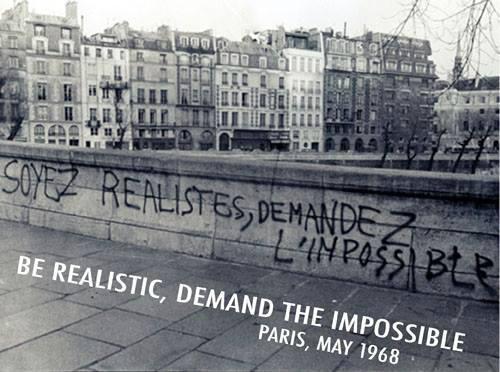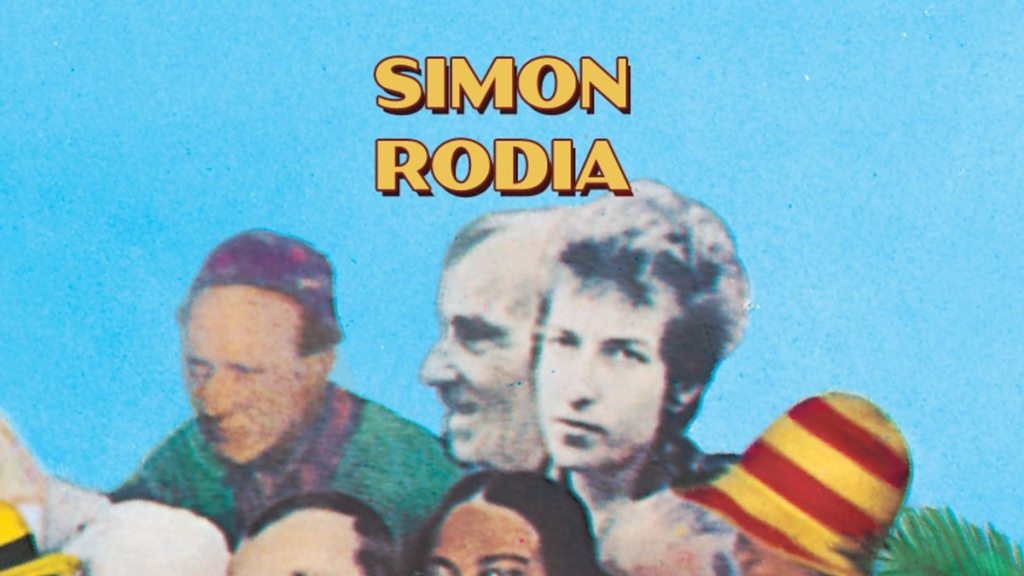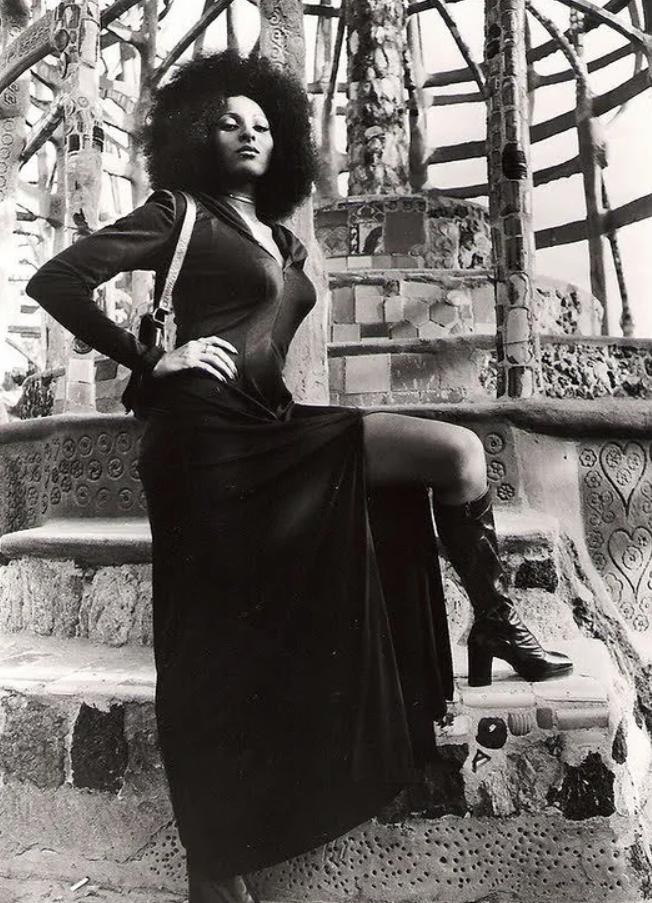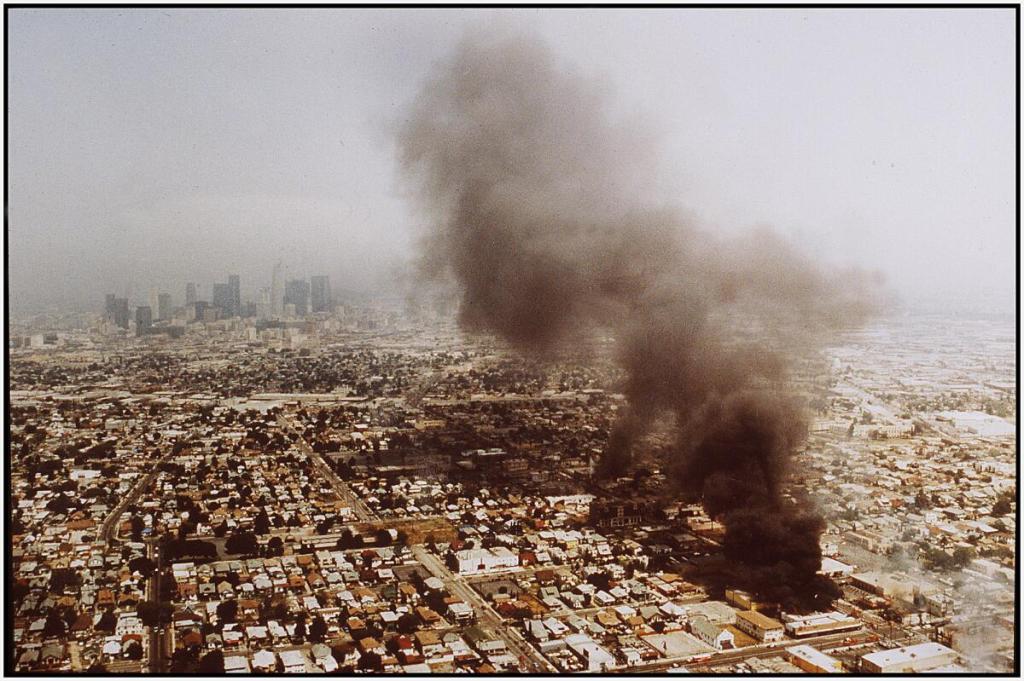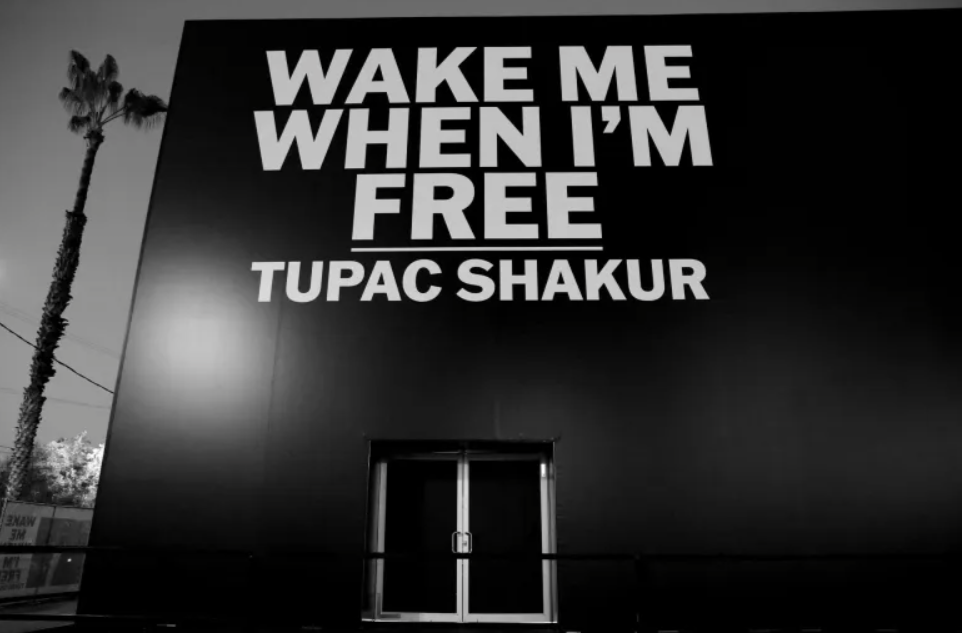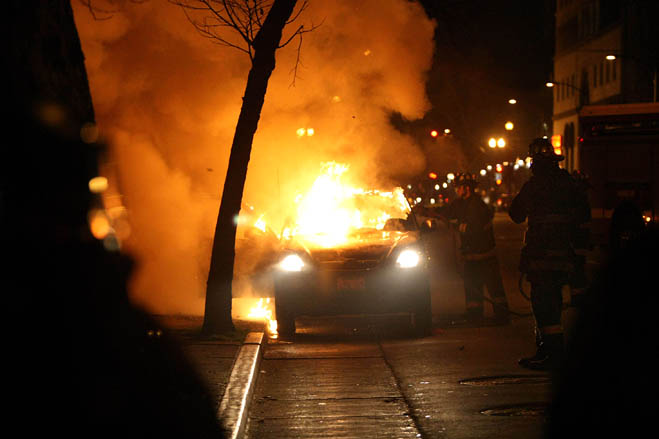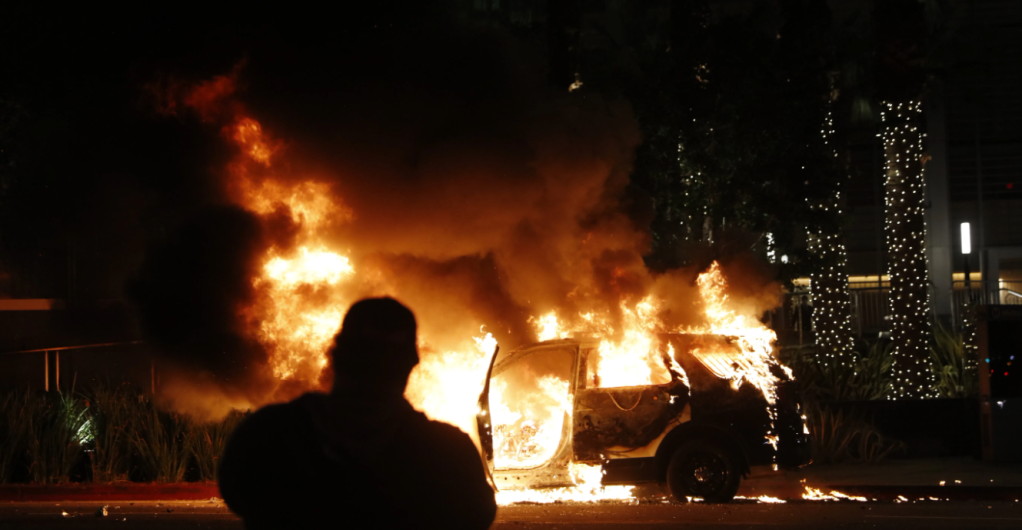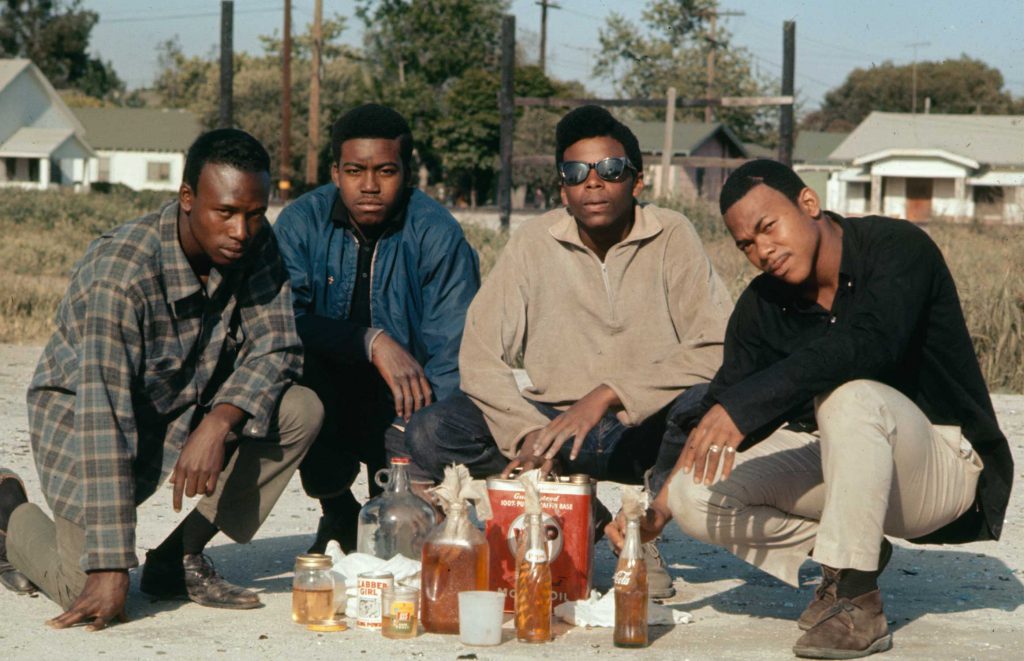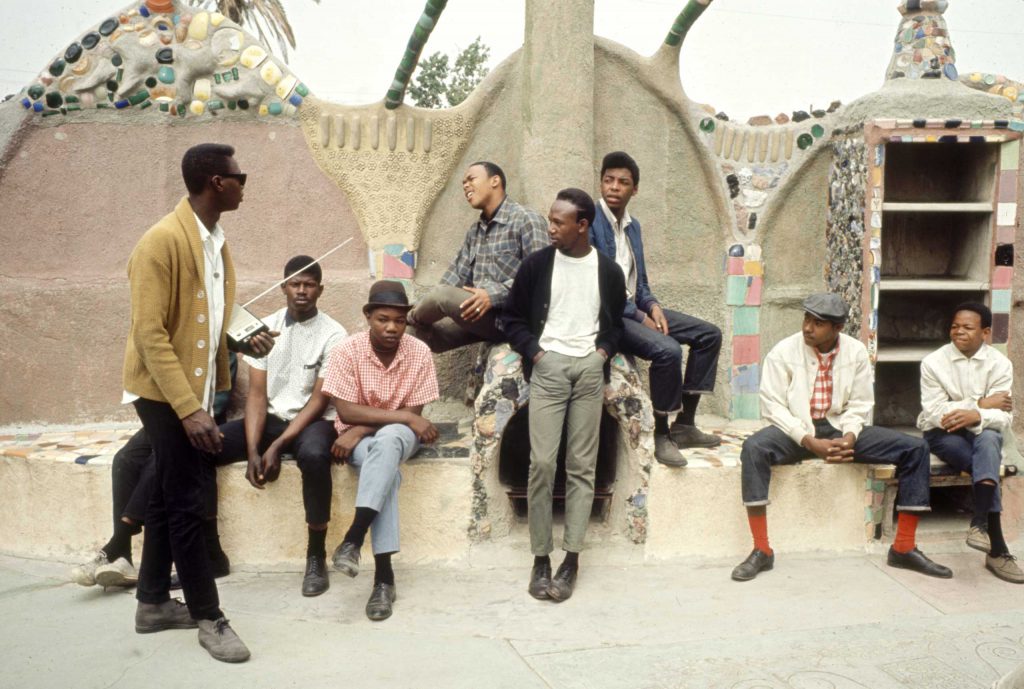California knows how to party
In the city of LA
In the city of good old Watts
-Tupac Shakur, California Love, 1995
I: Sleepless In Seattle
In the summer of 1910, an anarchist named Sabato Rodia arrived in Seattle, a humble Italian worker visiting his brother and their comrades. Later known to the world as Sam Rodia, back then he was Sabato; quiet, passionate, and fiercely committed to the beautiful idea of anarchism where there would no more masters or slaves but only free people living as equals, their imaginations and agency unchained from the constraints of church and capital, free to soar to unknown heights.
When he arrived in Seattle, thirty-five year-old Sabato had recently separated from his wife and was estranged from his three children. In May of 1909, his wife Lucia Ucci had gone to the police near Berkeley, California and claimed Sabato had given her a black eye. Later, after her husband was arrested, she went back to the police and claimed it was a mistake, that she got the black after falling down the stairs. Several months later, in February of 1910, he filed for divorce from Lucia under the charge of cruelty.
It would seem that Sabato was fleeing his old life down in Oakland and Berkeley, where he had lived with his wife and family since 1905. The sad part is that he met his wife in Seattle and lived there with her and their first son from 1902 to 1905. It would also seem that Sabato’s attempt at legal divorce from Lucia failed, or was never followed through on, but that didn’t stop him from leaving for Seattle in the summer of 1910. We only know he was there because of an Italian anarchist newspaper called Cronaca Sovversiva, the most important of its time, and in the July 16, 1910 issue, we find that Sabato donated 25 cents to the paper.
Alongside his brother Antonio, those listed as donating from Seattle that week include the great Ersilia Cavedagni and her young partner Leon Morel, a famed metal-caster. Ersilia was close comrades with Antonio Rodia, having known him since at least 1908, and it’s likely that they were both instrumental in opening the Social Studies Club at 1001 Weller Street in Seattle. While the doors of this space didn’t open to the public until December of 1910, it’s likely that the local Italian anarchists were using it as a private meeting hall in the lead up to the grand opening, and it’s highly possible Sabato Rodia met there with his brother, Ersilia, and Leon.
The Social Studies Club was located at the top of the bluff now known as Little Saigon, just on the border with Chinatown, or the International District. For many years, the Italian anarchists of Seattle who subscribed to Cronaca Sovversiva had their papers delivered to either a Japanese fruit stand at 801 Charles Street, or to an anonymous Italian grocery store somewhere in the city, and for this reason, neither historians nor the authorities knew where most of these anarchist subscribers lived.
II: The Short, Angry Life of Pellegrino Rodia
We don’t know where Antonio Rodia was living when his brother Sabato came to visit Seattle in the summer of 1910, but we do know that Antonio was still an off-and-on miner, just as his brother Sabato used to be. Many years before, in 1890, the first of the Rodia brothers left their town of Serino, Italy and traveled across the sea to Philadelphia. This was Pellegrino, born in 1875, and he soon found work in the Pennsylvania coal fields, a place where he spread the anarchism he’d absorbed in his native Italy.
From what information is available, we know that Pellegrino (literally pilgrim in Italian) worked and agitated in the Pennsylvania coal mines from 1890 until 1894, or in other words, from the age of 15 to 19. It was in 1894 that young Sabato, then 15 years-old, arrived in Philadelphia and joined his elder brother in the mines, a place where Sabato became a committed anarchist. As he would later explain in his broken English, his brother Pellegrino tell me many things. From him I learn many, many things.
It’s unclear when or where Pellegrino died, but by all accounts it was in a coal mine somewhere in Pennsylvania sometime in 1894, and the only major disaster that year was the Gaylord Mine collapse of February 13, 1894, where thirteen coal-miners were crushed to death under earth and rock. Once he arrived in the US, young Pellegrino used a variety of aliases, most likely to fool the authorities, and among them were Richard, Frank, Tony, and the most humorous Dick Sullivan. There was one Richard Davis listed among the dead coal miners, but whether this was Pellegrino Rodia will likely remain a mystery.
The death of Pellegrino left a deep, dark wound inside fifteen year-old Sabato, now alone in the US as a child coal miner. We know next to nothing about these sad years, and it can be assumed that Sabato remained a miner, given that his fourteen year-old brother Antonio eventually came to Pennsylvania in 1897 and also became a miner. We don’t know how long they worked and agitated as minatori anarchico, but we know that Sabato eventually married one Lucia Ucci in Seattle on September 13, 1902. He was 23 years-old.
III: West Coast Is The Best Coast
It’s unclear what Sabato did for work in those first years after his marriage, but given that he was a coal miner, it’s possible he worked in such coal towns as Black Diamond or Cle Elum, both anarchist hotbeds of the Cascade Mountains. If so, there’s no record of it. Some say he picked fruit on a farm, others say he was a general laborer going door to door, but everyone agrees that his son Frank Rodia was born in Seattle on June 26, 1903.
At some point between 1903 and 1905, the Rodia family moved to Oakland, and by most accounts, this is where Sabato began his career as a tile-setter and mason, his labor going into UC Berkeley buildings that still stand today. From this job, he not only supported his family, he brought his sister Angelina Colacurcio and her family from Philadelphia all the way to nearby Martinez, California. Back then, Martinez was still very much as environmentalist John Muir first found it when he moved there in the 1880s, all rolling grassy hills spotted with dark green oak trees, the glimmering bay glowing in nearly every direction.
With his sister living in this remote backwater of 2,000 souls, Sabato continued his work setting tile and laying brick, bringing in relatively high wages. However, as attested to by his children, his friends, and even himself, Sabato began drinking heavily, likely after work and into the night. It’s unclear if his wife Luccia was an anarchist, given their son Frank was baptized in Seattle, but it appears they often fought about Sabato’s convictions and beliefs. The extent of their domestic violence is also unclear, but their children had clear memories of fighting, both verbal and physical.
Whatever was happening, Sabato didn’t appear in any anarchist newspapers in this time, nor was his involvement in the local movement documented in any known source. Just across the bay, from 1903 to 1905, the great Ersilia Cavedagni lived in San Francisco, a vital member of the local anarchist nucleus, although there’s no proof she ever interacted with Sabato and his family in Oakland. Had she done so, Ersilia might have been sorely disappointed, given her ardent anarcha-feminism in such articles as La Donna. .
While he was in Oakland, his brother Antonio was in Los Angeles, donating 50 cents to Cronaca Sovversiva for its December 1, 1906 issue. After working as a coal miner in Pennsylvania, he eventually made it to the City of Angels for unknown reasons, doing who knows what. It would be easy to imagine him mingling with members of the Partido Liberal Mexicano such as Ricardo Flores Magón and Librado Rivera, who were busy planning an uprising in Mexico. Again, there is no proof of this, and by the May 11, 1907 issue of Cronaca Sovversiva, twenty-four year-old Antonio Rodia was still in Los Angeles, this time donating $1 to the newspaper.
Shortly after the arrest of Ricardo Flores Magón and Librado Rivera in August of 1907, we find that Antonio moved to Sacramento, for whatever reason. In a letter written on September 24, 1907 from the International Grocery at 1110 Third Street, young Antonio explained his fervent anarchist philosophy to his sweetheart Concettina, the sister of Lucia Ucci, wife of Sabato.
As he wrote, I am very happy that your sister Lucia is newly reunited with her husband, that is, Sabatino, if not for any other reason than because when children lose their mother, it is such a great loss, especially if the father were to remarry an unconscionable, that is, an ignorant Catholic. From this, it’s clear Lucia briefly left her husband and children, just as it’s clear she wasn’t just some ignorant Catholic.
Near the end of this mostly amorous letter, Antonio explained, I left the place where my brother and his family live, in order to no longer see that riff-raff, or that idiot woman you know, that is, Maria, who is not worthy of being loved, and doesn’t know the one who loves her and want to give women freedom, as much as a man may have. It’s unclear who this Maria is, but Antonio is clearly referring to Oakland, and it’s possible he briefly stayed there before heading to Sac-town.
When he did return to the Bay Area, he stayed away from his brother, with the November 16, 1907 issue of the Cronaca showing him donating $1 from San Francisco. Why he was there is unclear, as the city was still largely in ruins. However, shortly before he arrived, the Royal Consulate of Italy in San Francisco, which had been conducting surveillance on Antonio Rodia, sent a message to the Ministry of the Interior in Rome, explaining how it seems that a brother of said individual, named Sam Rodia, living in Oakland, California, has even more radical ideas than Antonio.
IV: Terremoto Anarchico
On April 18, 1906, a massive earthquake spread across the coast of California, and hardest hit was San Francisco, where a subsequent firestorm destroyed all of the old city. The famed Latin Quarter behind Telegraph Hill, a refuge for Italian anarchists, was entirely erased, and like many of their Italian neighbors, these anarchists got on a ferry and moved across the bay to Oakland.
While there is no Oakland address connected to Sabato Rodia and his family, it’s likely they lived in the Temescal district, known back then as Little Italy. Every house of Italians had rows of crops and fruit trees outside, and many of those trees still stand and breath today. After the earthquake, even more Italians flooded into the Temescal, and if he lived there, Sabato would have been in the thick of this deluge.
Among the Italian refugees were crews of Genovese garbage-men who had previously roamed the streets of San Francisco disposing of people’s waste for a fee. The scavengers, as they were called back then, only threw away what was truly useless waste, saving everything that could be repurposed, rebuilt, or resold.
If he lived in the Temescal during this time, Sabato would have grown used to this practice of roving scavenger crews who often competed with each other for territory as they scoured the ground for items of use. However, by 1909, all of these different crews had merged into the Oakland Scavenger Company, a formal co-op with equal pay for all members, and by the 1930s these bums were so rich they built their own social hall, the Ligure Club, named for their native region, and today it’s the Omni social center, a place still haunted by a few anarchists.
Before that, back in 1909, the year the Oakland Scavenger Company was formed, we find that Sabato and his family had moved way north up San Pablo Avenue to the still unincorporated community of Ocean View, which was also called West Berkeley back then. There is an entry in the May 1, 1909 issue of the Cronaca listing Antonio Rodia as donating from West Berkeley, but it still doesn’t confirm Sabato lived there, and Antonio was likely visiting. We only know Sabato lived there because of the May 19, 1909 issue of the San Francisco Call, which described the above-mentioned assault against Luccia, her black eye, and the subsequent jailing of Sabato.
As the article explained, Ocean View had no jail, so he was put under guard in the school house. When the matter went before a judge, the prosecuting attorney was one E.W. Cutchin, the first man in Ocean View to bring shotguns to bear on the scavengers of Berkeley. Against this type of man, Luccia testified that she fell downstairs and refused to utter one word against her husband’s character. Despite all this, Sabato still filed for divorce in February of 1910, as mentioned above, and the charge was simple cruelty. According to a 1910 census record, he listed himself as divorced and caring for his two sons, although the divorce wasn’t legal. This is the only available context for what happened between Sabato and Luccia, and when he left his family for Seattle in the summer of 1910, a giant earthquake ripped open the heart of this committed anarchist.
V: The Years of Lead
As mentioned before, Sabato didn’t stay in Seattle long, although he did meet Ersilia Cavedagni and Leon Morel, if he hadn’t already. Antonio had been up there since 1908, thick as thieves with Ersilia and the whole bunch, especially his close friend Michele Bombino, who he had gone to Walla Walla, Washington with in 1909, possibly to work in the few coal mines, but likely as agricultural workers.
Despite all these comrades, Sabato left Seattle and returned to his family in West Berkeley, as shown by his 50 cent donation from there in the August 13, 1910 issue of the Cronaca. This is the final mention of Sabato Rodia in that newspaper, and only his brother Antonio appears in the subsequent donation columns, such as the November 19, 1910 issue, where he donates $1 from Seattle alongside Michele Bombino, Ersilia Cavedagni, and Leon Morel.
On December 17, 1910, the Social Studies Club at 1001 Waller Street in Seattle was formally opened in an announcement written by Antonio for the Cronaca Sovversiva. As he told the reader, in order to intensify the propaganda of the great and sublime anarchist ideal among the Italian element of Seattle, we have decided to establish a Social Studies Club. As he explained, this clubhouse would be open every evening, and meetings will be held every Sunday after lunch, at 2 pm.
Given it was Antonio who wrote this announcement, it can be assumed he played a significant role in its founding, and many comrades recalled this clubhouse fondly. Annibale Sciado recalled, I was there reading, and had a comfortable place to sit down, a good place to go, like men who have no house, no joy of family, no children. Another comrade, one Constantino D’Ascenco, described it as a place where a fellow could go–women, children, men, everybody, where we could go and read books. Sometimes we used to go there and get warm by the fire. In rainy Seattle, this warmth was very welcome, and one Batista Querio remembered that there was a stove in there and books and a fellow could go in there and study and pass the time away.
Within weeks of announcing the clubhouse opening, Antonio Rodia and his close friend Michele Bombino were up north in Vancouver, BC for a lecture event that raised $30, as reported in the December 24, 1910 issue of the Cronaca. As of the January 21, 1911 issue, Antonio was back in Seattle, along with his comrade Michele Bombino, and they remained there up through the March 18 issue. The only sign of their return to Seattle comes from another newspaper, The Agitator, published from the anarchist community of Home, the place where Ersilia Cavedagni and Leon Morel owned a metal-foundry.
In the April 1, 1911 issue of The Agitator, we learn that a benefit was held for the newspaper at the Social Studies Club, or the Italian club rooms, and according to the report-back, the meeting, though small in size, made up tenfold in spirit, as you can see by the donations, which amount to $45.00. In the donation column below this report, we find Antonio Rodia and Michele Bombino each donating $1.00. However, both of them soon traveled to the coal-town of Cle Elum, Washington where Antonio would write a detailed report of conditions there for the April 29 issue of the Cronaca, his longest published article.
Shortly before this Cle Elum article was published, Antonio left Seattle with Michele Bombino, Michele Cirpriani, Vincenzo Cipolla, Domenico Marino, Giuseppe Piccirillo, Michele Ricci, and these men all traveled south towards the Mexican border. On the way, they gathered Sabato Rodia in West Berkeley, and within days they were all armed and equipped for an insurrection along the US border with Mexico.
It’s unclear how the Seattle gruppo was connected enough to join this infamous uprising that began the Mexican Revolution, but as mentioned above, Antonio had resided in Los Angeles between 1906 and 1907, the same time as Ricardo Flores Magón and other members of the PLM. The fact that Antonio was part of that lightning invasion lends some credence to the idea that he was known by Ricardo Flores Magón and the PLM, and so it was that Antonio, his brother Sabato, and six other Italian anarchists took their rifles and seize several border towns with a bunch of crazy rebels.
Once the quick victory had transpired in Mexicali, the insurgent army occupied Tijuana on March 18, 1911 where a flag reading Tierra y Libertad was lifted over the town and the insurrectos waited for the counter-attack. Meanwhile, fighting had erupted across the entire northern border, the insurgents composed of anarchists and indigenous, all in open revolt against the dictator Porfirio Díaz. While the victories were much more certain in Ciudad Juarez and Mexicali, the insurgents of Tijuana were eventually driven back across the US border by the Mexican federales, although it was too late for Díaz. With that first battle, his dictatorship began to swiftly crumble, and among those who made it possible was Sabato Rodia and his Italian comrades.
Antonio returned north after the federales reclaimed Tijuana, appearing in Kellogg, Idaho as of the September 30, 1911 issue of the Cronaca, and it’s likely he worked and agitated in one of the many silver mines of that industrial town. While he was in Kellogg, it’s unclear where his brother Sabato was, and it’s highly likely he never returned from Mexico. Whatever the context of his domestic violence with Luccia, combined with his alcoholism, it’s clear that Sabato was at rock bottom when he helped invade Tijuana, both as a human and an anarchist.
In the January 24, 1912 issue of the San Francisco Call, we find that Luccia had filed for divorce from Sabato on grounds of desertion and cruelty, meaning he had deserted her. This would be the last public mention of Sabato for several years, and no one seems to know anything about what he did between 1912 and 1917. However, according to his brother-in-law Saverio Colacurcio, he left that wife in Albany [formerly West Berkeley] and ran off to Mexico where he became mixed-up with a Mexican girl, some hot-blooded brothers, and a revolution.
Given all the facts, along with Sabato’s near total disappearance, it seems highly probable that he spent the years 1912-1917 fighting in the great Mexican Revolution. While his brother Antonio earned the wrath of Ricardo Flores Magón for doubting the course of the revolution, even being named in Regeneración as a boaster, it seems that Sabato vanished into Mexico, and not even Antonio knew where he was.
The March 2, 1912 issue of the Cronaca included a brief item on the back page that stated: Comrade Antonio Rodia, Box 27 of Kellogg, Idaho wants to hear from his brother Sam, or Sabatino Rodia. Anyone who knows his address is asked to let him know. While he was up in Idaho with the silver miners, his old friend Michele Bombino was in Los Angeles, still good friends with Ricardo Flores Magón, donating with him at a memorial to the murdered anarchist educator Francisco Ferrer on December 10, 1911.
After that, little was heard from Michele Bombino until he showed back up in the Pacific Northwest, giving a speech at the Eagle’s Hall in Tacoma in late September, 1912. In between these dates, it seems Michele Bombino was also fighting in the Mexican Revolution, not becoming a cynic like his comrade Antonio Rodia, busy slaving away in the Kellogg silver mines. Nevertheless, by the beginning of 1913, not only was Antonio in Vancouver, BC, but so was Michele Bombino, Ersilia Cavedagni, Leon Morel, and a host of other Italian anarchists, and by all accounts, it seems they proceeded to cause an uprising in the coal-mines of Vancouver Island.
However, there was no word from Sabato, and Antonio eventually drifted back down to California, being listed as donating to the Cronaca from San Francisco, Pittsburgh (CA), and even Martinez, the town where Sabato had financed their sister Angelina’s relocation. When he donated $1 from that oak-shrouded backwater, the year was 1916, and nothing had been heard of his beloved Sabatino.
The great Mexican Revolution is too complex a conflict to be quickly summarized, but in broad strokes, the sometimes-ally of the PLM, the rebel landowner Francisco Madero, overthrew the dictator in 1911 and seized state power, leading to the Zapatista uprising in Morelos that same year. Madero’s government was officially against this rebellion, but Madero refused to crush the Zapatistas, and by 1913 he had been assassinated. With the government now helmed by the military warlord Huerta, only the PLM, the Zapatistas, and the forces of Pancho Villa remained close to the initial anarchist vision of the great revolution.
The influence of Villa and Zapata culminated in the sacking of Mexico City in December of 1914, the very height of that moment of promise. Soon afterward, the warlord Carranza took state power and began to fight against the forces of Villa and Zapata, and in the middle of all this, Villa decided to raid a small town in New Mexico on March 9, 1916.
His attack on Columbus, a highly charged name, sent the US into a frenzy, and soon the Army had invaded northern Mexico, from Arizona to Texas. For over four months, US troops fought both the forces of Villa and the forces of Carranza, who were themselves at war. After hundreds of deaths, the US and Carranza began negotiations, and the US withdrew in January of 1917. By then, Villa’s forces were exhausted, having lost nearly 200 comrades, and Zapata remained the final hope, only he was far to the south in Morelos.
And so it would be that, had Sabato been fighting in the Mexican Revolution, he would have emerged out of that dark moment precisely on the Texas border with Mexico, just across the river from Ciudad Juarez in the wild city of El Paso, once used as a staging ground in 1911 for the great uprising. The first record of Sabato’s reappearance is as a janitor and porter at the Martin, an office building in the heart of downtown El Paso, and we know this from Sabato’s draft card for WWI, which he filled out sometime in the spring of 1917. In this same document, Sabato was married to a Mexican woman named Benita Chacon. Beyond this, he was now fluent in Spanish, a man who could barely speak modern Italian and was previously fluent only in his native Irpino dialect, as well as possessing some broken English.
VI: The Times of Chaos
The Martin Building was still under construction in January of 1917, but it was open enough for Sabato to have a job there by the spring. He held open doors, checked coats and bags, swept the floors, cleaned the bathroom, took out the trash, and then went home to Benita Chacon, who we know basically nothing about.
It’s unclear exactly when they met, but on January 28, 1917, the infamous Bath Riots took place in El Paso when a woman named Carmelita Torres refused to submit to the new border crossing measures enacted in response to the Mexican Revolution, measures that included people having to strip naked, their clothes chemically sanitized and steamed, their bodies sprayed down with kerosene and soap, and their arms pricked with vaccination needles.
Carmelita said no to all of this, and soon all of the Mexican women were saying no, leading to a massive riot of several thousand people. The riot continued on into the next day, mostly on the Mexican side of the border, and supporters of Villa used this as a chance to challenge the police and soldiers of Carranza, who controlled Ciudad Juarez, the other half of El Paso. The riots got wilder the second night, and in the days to come Mexican workers went on strike, throwing the Anglo business-owners of El Paso into a crisis. The riots ended after those first two days, and the strike evaporated when new rules allowed exemptions for those who had a certificate of health from a Mexican doctor.
All of this was just a prelude to the Immigration Act of 1917, which went into effect on February 5, 1917, requiring literacy tests for all immigrants attempting to enter the US, as well as a tax. This lasted only a few months until shortly after the US entered WWI in April of 1917, and given the need for exploitable workers in the country, the government had to grant an exemption to their new Immigration Act. All this to say, Sabato was widely known to be illiterate, so he must have gotten back into the US before the Bath Riots, as he was already working at the Martin by the time the WWI immigration exemptions were enacted.
The El Paso City Directory for 1918 lists Sabato as working at the Martin, although he didn’t list his address until the 1919 issue of the Directory, revealing he lived at 313 S. Campbell Street, just a short walk from his job. This was where Sabato and Benita Chacon were living on June 15, 1919 when the remnants of Pancho Villa’s army attacked Ciudad Juarez just across the river. While the main target was a fortress of Carranza’s forces, the US military got involved in suppressing Villa’s effort, and he eventually withdrew after losing over 150 men. This was nearly the end for Villa, and after a final disastrous raid in Durango, the once great Pancho Villa retreated into his beloved mountains and surrendered to Carranza, being given a pardon and the right to live in his hacienda.
For whatever reason, this is precisely the moment that Sabato and Benita left El Paso and moved west to the oceanside town of Long Beach, California. We know nothing about what Sabato and Benita felt about Pancho Villa, we only know Sabato was an anarchist, but it’s not hard to imagine them both being sympathetic to Pancho Villa, not the forces of Carranza who controlled Ciudad Juarez, the other half of El Paso. Villa would have been their only hope, given Zapata was assassinated in April of 1919, so when Villa surrendered, it’s possible that Sabato also gave up, along with Benita Chacon.
Their choice of Long Beach is also interesting, given that it was the former stomping ground of Joe Hill, a man who fought with Sabato in Mexicali and Tijuana. One can imagine them together, forming some sort of bond during that frenzied military campaign, and the execution of Joe Hill, maker of music, might have hit Sabato deep in the heart. Despite all this conjecture, what is certain is that Long Beach was one of the few places an Italian man and a Mexican woman could live openly as man and wife.
We don’t know exactly when they left El Paso, but a document claims Sabato had been working in Long Beach about a year before June 19, 1920. They’re both in the Long Beach City Directory for the beginning of 1920, listed together as living at 1204 Redondo Avenue, about two miles north of the Pacific Ocean. The previously mentioned document was a letter of recommendation written by the Markwell Building Company, who employed Sabato as a bricklayer and tile setter from 1919 to 1920. After years of revolution, Sabato was now just a humble mason living by the sea, his past now clouded by all that he had just lived through.
VII: The Shards of Light
While all of this was happening, Sabato’s brother Antonia Rodia moved to Martinez, California near his sister, and while he was living there, his old comrade Michele Bombino was living in San Francisco, having left Seattle sometime after the September 11, 1915 issue of the Cronaca.
Both were still very active in the Bay Area, and as is recorded in the September 23, 1916 issue of the Cronaca, Bombino helped organize a benefit for those arrested after the Preparedness Day bombing of July 22, 1916, during which he told the audience, if the bomb was placed by an obscure and anonymous proletarian to indicate to the powerful that among the humble and docile here there are still those who see, fight, and hope, blessed be that hand and that avenger, who deserves the solidarity of myself and all the exploited.
Just four days before this transcription was printed, on September 19, 1916, Michele Bombino was arrested on a street corner along with nine other Italians for loudly denouncing the guilty verdict against Warren K. Billing for the Preparedness Day bombing. Bombino served several weeks in jail for disturbing the peace.
In the September 30, 1916 issue of the Cronaca, we find Antonio Rodia writing across the bay from Martinez, even though I know this isn’t the best way to come to the aid of those arrested in [the Minnesota Mesabi Iron Strike], I was nevertheless able to collect the sum of $11.00 from the slaves of this small California vendée.
Months later, on March 3, 1917, the police arrested Michele Bombino for using counterfeit currency, along with his comrades Vincenzo Ferrero, F. Rossi, and N. Molinari, and all but Ferrero were sentenced to a year in prison. While his old friend was behind bars, Antonio Rodia remained in Martinez, and apparently he had been busy, for in the July 28, 1917 issue of the Cronaca, we see that there were now twelve anarchists in Martinez, in addition to him, and together they raised $11.75 for the many persecuted comrades in the US.
This is where we lose track of both Antonio Rodia and Michele Bombino, their names no longer in the Cronaca. It’s unknown what happened to either of them, but if Antonio Rodia remained in Martinez beyond 1917, he would have eventually seen his brother again, for Sabato would return to visit his sister and her family, leaving behind pieces of his wild, luminous art.
VIII: The Great Transmitter of Watts
For whatever reason, Sabato Rodia and his wife Benita Chacon are listed in the Long Beach City Directory for 1921, although their names are misspelled, and they appear to have moved from 1204 Redondo to 1117 Grand Avenue, just a few blocks away. That same year, Sabato used his new income from construction to buy a lot in Watts, and in his spare time he began assembling sand, cement, steel bars, and wire mesh at this new lot, all for some purpose known only to Sabato, and possibly Benita Chacon, who appears to have become weary of Sabato and his strange dreams.
Uncannily, Sabato and Benito are listed in the 1922 Long Beach City Directory as having moved again, this time relocating one block away from 1117 Grand Avenue to 1117 Euclid Avenue. It seems that Sabato built this house on Euclid, and soon he began to surround it with a cement wall that he filled with glass, shells from the beach, broken tile, or anything else he found on his rambles.
Like the Oakland Scavenger Company from his days in the Bay Area, a now 43 year-old Sabato would wander around Long Beach looking for objects to reclaim for his creations. For example, a circular bench he built at 1117 Euclid was crowned with arches that used sea-shells, door-handles, and other found materials embedded into the cement to form spiral-shaped hearts and flower-like patterns.
A similar style of wall lined the whole property, just as there was a spinning merry-go-round structure near his hand-tiled walkway. He also made many flower pots ornamented in the same manner, giving one of them to the Zamorano family who lived next door. Sabato gifted them this artwork before leaving his hand-made home. Another of these pots would eventually make it up to his sister’s house in Martinez, but not for a few years. All we know is that Sabato moved from his house on Euclid shortly after his second wife Benita Chacon left him for unknown reasons.
In this time, he was not known to drink, but he had become a fervent Spanish-language evangelical preacher, spouting his sermons on what he called true liberty. If anything, it seems more likely that Benita left him because of this religious conversion, rather than domestic violence or alcoholism, given none of their neighbors remembered any violence. It’s unclear how much of Sabato’s new gospel was simply a cover for his anarchism, given the 1920s were a deadly time for the old Italian crews that supported Cronaca Sovversiva.
However, with this newfound religion of true liberty, Sabato moved away from Long Beach to the then sparsely developed city of Watts, a place where Blacks, Mexicans, Philipinos, and Italians all lived together, shunted away from the racially restricted neighborhoods of greater Los Angeles. Sabato was now making good money as a mason and tile-worker, and he was even considering moving to Beverly Hills before he learned Italians couldn’t live there, so he chose a property along the electric Red Car line at 1765 Robin Street (now 107th Street).
All it had was a small two bedroom house and tiny outbuilding, and from here he continued work on his mysterious creation, pouring a large circular cement foundation reinforced with steel beams. Before leaving Long Beach, back in 1921, he had begun building his ornamented cement walls around his triangle shaped plot in Watts, and in the entranceway arches he embedded the year 1921, proof to the world of when his creation began, a number he would embed numerous times as the structure continued to grow.
Again, no one knows very much about Benita Chacon, nor why she left Sabato, but some accounts have her returning to El Paso after their divorce. Everyone also seems to agree that by 1922 a Mexican woman named Carmen had moved into 1765 Robin Street with Sabato, and that they lived together for several years. The neighboring family, the Garcias, would recall that Carmen eventually left Sabato, walking out of the house with many of his possessions. For the rest of his days in Watts, Sabato would live in a nearly empty house, alone.
By 1926, the City of Los Angeles absorbed little Watts, and Robin Street was renamed 107th Street. At that point, anyone traveling to Watts on the electric Red Car would have seen the first of Sabato’s massive towers rising into the air, a 26-foot cone supported by a central column and buttressed with curved, ornamented bars of steel, wire mesh, and cement. In front of this was the spire of a ceramic boat, the Ship of Marco Polo.
Sabato was known to either talk kindly and politely to everyone he encountered in the neighborhood, or he was known to walk silently, brooding on his next construction moves. In the early morning, he would head off to work, laying tile or brick for Hollywood studios, swanky new restaurants, or pleasure palaces of newly minted stars.
At the end of the day, he would return to Watts on the electric Red Car with sacks of broken tile, which he would carry home for all to see and then dump into the appropriate bin of his open-air workshop. Sometimes, he would fire up his cement and mosaic oven and bake bread, the smoke wafting out a chimney embedded into the wall surrounding his towers.
Literally thousands of Watts children grew up watching Sabato build his towers, and by 1933 the second one had risen to its full height, nearly 98 feet. That same year, a 6.4 magnitude earthquake struck offshore of Long Beach, toppling hundreds of buildings, killing over 100 people, but leaving all of Sabato’s towers standing, a miracle witnessed by the whole of Watts.
Sabato was known to pay local children either pennies or candy to gather him green glass bottles or seashells from the beach, all to be used in his towers. More than any color, Sabato was partial to green, having a special attachment to transparent green 7-Up bottles. Not only did the children go scavenging for Sabato while he was at work, they would often sneak into his compound to play on his creations, for which he would often chase them out.
One of the children who watched the towers rise was named Charles Mingus, a talented child with a gift for music. Just like Sabato, young Charles had no formal training in what he excelled at (he couldn’t read music), and to the end of his days, this legendary jazz bassist would fondly recall the towers and cited them as an inspiration. In fact, Charles himself was one of the children who snuck in to marvel at the creation, and he described the towers as something strange and mysterious. Charles wasn’t alone, for it wasn’t just children, but also the adults of Watts who felt the wonder of the inexplicable towers that transmitted a message of total freedom, or true liberty, as Sabato called it.
Sabato kept working after Charles Mingus went to New York in the late 1930s, and every day he lived in Watts, this strange anarchist was known to talk with everyone, at least when he wasn’t lost in deep thought. It’s unknown how many Watts residents he influenced, especially the children, but his rhetoric never lost its anarchist charge, and below is a selection of transcriptions from the man himself, assembled in no particular order:
When the man looking for a job, he’s no free and they thinking they free. Poor class of people all over the world, they no free. Woman, too. Woman no free. Woman get a job in the store. You got to do what the boss want, wrong or no wrong. “Do what I tell you,” he say. Good, good, good, or bad, bad, bad. You be half good and half no good, well, that’s no good. You got to do something they never got ‘em in the world. I build the tower the people like, everybody come.
These are the types of ramblings the residents of Watts grew used to from their eccentric neighbor Sabato Rodio, or Old Man Sam, and rather than be known as some crazy anarchist, he was known as a crazy evangelical preacher, which likely kept him safe. There is no way to measure how vast his influence was in early Watts, but we do know what he named his towers: Nuestra Pueblo, or Our Village, in Spanish. In some contexts, it can also mean Our People.
IX: Charging The Tower
Sabato worked steadily through the 1930s, eventually beginning the third and largest tower. Rather than a central column running through the center, as was the case with his previous towers, the third had a multidimensional column of many shapes and configurations, the height of his talent as a builder. As with the others, he used no scaffolding, instead building as he went, using only nine simple tools from the previous century. He had no help and did everything alone, aside from the swarms of children he employed to gather green glass while he was laying brick and tile for the Hollywood elite.
Not only did he scavenge glass like the Oakland Scavenger Company of the old days, not only did he give the neighborhood kids something to do, he utilized everything he found in his endless construction: bowling balls, broken plates, tea kettles, cowboy boots, anything he found on the side of the tracks, in abandoned lots, in gutted homes. Over time, the poor white Italian children vanished from the streets of Watts and the majority were now Black and Mexican, and by the late 1930s, over 70% of the Black people in Los Angeles lived around Watts, given it was still free from racial housing restrictions.
By 1940, over half of the third tower was complete, with Sabato working until late into the night, hanging up there with bare hands and buckets of cement. He kept building throughout WWII, and while he did fill out his draft card, he was too old to be conscripted and lived at ease in a now denser, more populated Watts. The war also brought over 10,000 more Black people into the community, all of whom grew used to the viejo loco and his towers rising to the sky.
These towers were simply part of the cultural fabric of Watts, with a Black jazz club just a block away, the famous Barrelhouse run by Johnny Otis. People didn’t necessarily understand what Sabato was doing, and jazz musician Buddy Collette recalled, nobody said, ‘There’s a genius over there; this guy [Rodia] knows what he’s doing.’ I just think nobody had been on that level. Nevertheless, the towers were seared into the minds of all who lived near them, who saw it on the daily, on the weekly, year after year.
At some point in the late 1940s, the old-time anarchist artist Man Ray made his way to Watts and took a photograph of Nuestra Pueblo, a positive moment in an otherwise bleak trip, for old Manny didn’t much like the US, and was only there to escape the Nazis. Man Ray was once a frequenter of the Ferrer Center in New York City, an illustrator for the anarchist Mother Earth newspaper, and was a personal friend of Emma Goldman, among many of the Greenwich Village anarchist scene. It’s unclear if he knew who Sabato was, but like a moth to a flame, one old-school anarchist found another in those dark times.
Soon enough, a famous designer and artist named Charles Eames came to photograph the towers, and starting with Man Ray’s visit, the outside world began to grow curious. The towers were featured on the July 1951 issue of Arts and Architecture, followed by a brief mention in Time Magazine, one in Architectural Review, and then an article in Harper’s for the December 1952 issue.
Things were heating up in the US during this time, and the author who wrote about Nuestra Pueblo for Arts and Architecture was soon embroiled in conflict with the LA City Council, who believed certain modernist artworks were subversive, degenerate, and communistic. The Cold War was gathering steam month by month, but this didn’t stop a flood of visitors to Nuestra Pueblo, including an architect named Juan O’Gorman who built part of the UNAM in Mexico City, which was certainly a communistic place.
However, these illustrious outsiders did nothing to stop the swift and rapid decline of Watts as a Black cultural mecca, at least not immediately. As famously illustrated in the children’s film Who Framed Roger Rabbit?, the electric Red Car line was bought out by a petro-chemical conspiracy and allowed to deteriorate until it collapsed. When this cheap electric train ceased its operations through Watts, those without cars were effectively stuck there.
And so it was that in 1953, when racial restrictions were officially voided across LA, the wealthier Black families moved out of Watts, taking their money with them. Meanwhile, the LAPD had gone hog-wild raiding the Watts jazz bars for any reason, a practice they would soon extend to the alleged communists of Hollywood. Just like the Black mecca of 7th Street in Oakland, the Black mecca of Central Avenue in Watts became a desolate ghost town. Darkness was surrounding the neighborhood, but Sabato kept working.
One day in the winter of 1954, while clinging to the superstructure of the third tower, now at 99.5 feet, Sabato suffered some type of stroke and fell. It’s amazing that he survived, but that was his last day of work, given parts of his body were paralyzed. He was 74 years-old, and he knew it was time to go. Many years before, crazy Sabato had gone to Sacramento and waited until he got a permit to build as he liked, but the increasingly reactionary City of Los Angeles was always causing him grief with local permitting, so on February 9, 1954, he deeded the entire property over to his longtime neighbor and friend Louis H. Sauceda.
Sabato moved north to the Bay Area and settled with his sister Angelina in Martinez, a place he had visited intermittently over the years (likely during his trips to nearby Sacramento). Her yard was already strewn with his creations, and he appears to have lived a simple, peaceful life. Despite his sister’s fervent Catholicism, he preferred not to die alone like a dog, as he said.
While there is no certainty, there are records for one Tony Rodia who lived in Martinez as of 1950, and while he appears to change his age in various government forms, it’s highly likely Tony is none other than Antonio Rodia. If this is in fact Sabato’s brother, he was born in Italy, was married to one Pauline Rodia, had a son, was generally the same age as Antonio Rodia, and worked as a machinist in the oil refineries that sprang up during the 1920s, spreading inland from the initial Standard Oil refinery in Richmond. Martinez had now become a gnarly industrial city, a far cry from the oak-land refuge of the environmentalist John Muir, and it was here that the Rodia brothers likely reunited, even before Sabato moved there.
Two years into his retirement, the Nuestra Pueblo of Sabato Rodia came under threat in 1957 when the local government ordered the work destroyed, part of its campaign to clean up slum and blight conditions, conditions these white politicians had found in this now majority black neighborhood. This type of racist urban renewal was happening across the entire US at the time, but when the residents of Watts organized to oppose it, they focused their energy on saving Nuestra Pueblo.
Shortly before the campaign to destroy the towers, the longtime house of Sabato Rodia burned, allegedly from an errant firework. This was enough to embolden the City in their accusations of blight, and in response to the impending destruction, the Committee for Simon Rodia’s Towers in Watts (CSRTW) was formed in 1959. It eventually organized a stress test of the towers where a cable was tied to each one and then pulled with 10,000 pounds of force. None of the towers buckled, and the City couldn’t deem them a hazard.
Before this stress-test, the friend of a documentarian who made a film called The Towers decided to buy the property for $3,000. When they went to the City to get permission to rebuild a caretaker’s house for the towers, they discovered the destruction was imminent, and so they helped form the CSRTW, which organized the successful stress-test. Oddly enough, among the Committee was Kate Steinitz, the famous Dada artist, and she ensured the global high-art world knew of what was at stake with Nuestra Pueblo. In response, longtime fans of Rodia like Buckminster Fuller made statements of support, giving that much more of an aura to the towers.
Thank to the direct influence of Kate Steinitz, photographs of the tours were including in a New York Museum of Art show in July of 1961 titled The Art of Assemblage, with every piece using collage art made by fastening together cut or torn pieces of paper, clippings from newspapers, photographs, bits of cloth, fragments of wood, metal or other such materials, shells or stone, or even objects such as knives and forks, chairs and tables, parts of dolls and mannequins, and automobile fenders. At a time when such works weren’t popular, Rodia’s towers stood as a supreme example of what they called assemblage, a fancier word for scavenge, Sabato Rodia’s second favorite pastime.
Regardless of this art-world praise, something more important was happening back in Watts. On the cement pad where Sabato’s house once stood, the CSRTW held their first summer school sessions in 1961, utilizing a large tent as their classroom. For the first time since Sabato left Watts, neighborhood kids were coming to the towers, this time expressly allowed to wander beneath the seemingly countless columns and ornaments.
In 1962, the Watts Towers Arts Center was founded in a house purchased by the CSRTW and run by a former social worker and Black artist named Noah Purifoy, a white activist named Sue Welch, and the Black musician Judson Powell. In honor of Sabato, these teachers would take their students scavenging throughout Watts and make art from what they found, just as they began filling Watts with light after a period of darkness.
While the City ignored Watts and offered little to no services, the Watts Tower Art Center not only protected Nuestra Pueblo, they reminded the neighborhood that it was possible to create beauty, just as Sabato did, and from this act of creation, one could draw immense strength, and not just the creator, but those who experience that creation.
By 1965, the Art Center had held three successful summer programs and a variety of other events. In April of that year, they organized Operation Teacup, which would repaint all the houses on 107th Street, for free, and afterwards there was a fun block party outside the towers. The neighborhood was literally becoming brighter again, and with his transmitter now in good hands, Sabato Rodia passed away in Martinez on July 16 at the age of 86. Many had called him un viejo loco, or a crazy old man, but many also knew he was a brujo, a male witch, a wizard. Three weeks after Sabaro’s death, an uprising broke out within blocks of his transmitter, and an entirely new era began.
X: The First Watts Transmission
On August 11, 1965, a California Highway Patrol officer pulled over a young Black man named Marquette Frye, a resident of Watts. When the officer arrested Marquette for drunk driving, his passenger brother went to get their mother, their mother came out to protest, and soon enough more cops arrived, a fight broke out, the mother and brother were also arrested, and by then the entire neighborhood was throwing rocks and bottles at the police. All of this occurred less than ten blocks from the anarchist transmitter of Sabato Rodia, his towers visible to every rioter.
Within a day, the guns had come out, seemingly all of them, just as looting and arson spread wildly, mostly against white-owned businesses. Pitched gun battles with the police and national guard were occuring on the streets, but the only two cops that died were killed by other cops, while the Black insurgents were shot down in cold blood, some after being told to strip down once they surrendered. By the night of August 16, over 3,000 people had been arrested, over 1,000 injured, and 34 people killed. Over 200 buildings were completely destroyed, hundreds more heavily damaged, and the cost of this insurrection was nearly $40 million. It was said that over 30,000 people participated, very actively.
Without question, thousands of those insurgents grew up hearing crazy Old Sam muttering about sticking it to the bosses between his discourses on gathering glass and seashells. There is no way to quantify the influence he had on the youth of Watts, but it was not insignificant. During the whole of the uprising, no one touched Nuestra Pueblo, nor did they harm the Watts Towers Art Center, and once the smoke had cleared, the staff and students continued their summer 1965 program, only now they scavenged three tons from the ruins of the looting and arson, turning their gleanings into art, something Sabato would have approved of.
It wasn’t just the students who fashioned art in this manner, and the instructor Noah Purifoy composed one of the most striking pieces, simply titled Watts Riots, made entirely from the charred remains of what had been destroyed. They assembled all these pieces and then took them on the road for a show called 66 Signs of Neon, in honor of the burnt neon tubes that looked so beautiful when they melted. Not only did they go on the road, they sold a bunch of these pieces to raise money for the Watts Towers Art Center, all at a time when the Watts Uprising was seen as the first definitive shift away from the non-violence of Martin Luther King Jr. People were no longer looking at Selma, they were looking at Watts.
The events in Watts accelerated a series of urban uprisings that spread across the US, and by 1968 there had been over 200 of them, and they increased once Martin Luther King Jr. was assassinated by the government for speaking against the Vietnam War. In part, the Black Panther Party was formed out of a desire for these uprisings to be channeled into a more positive, conscious form, albeit armed, and most accounts agree that the Watts Uprising was the true beginning of the wave of violence aimed at the racist, capitalist state of the US. And yet, hidden in its very core, was a vibrant fount of creation, one that continued to flow even after that first transmission spread the message of Watts across the world.
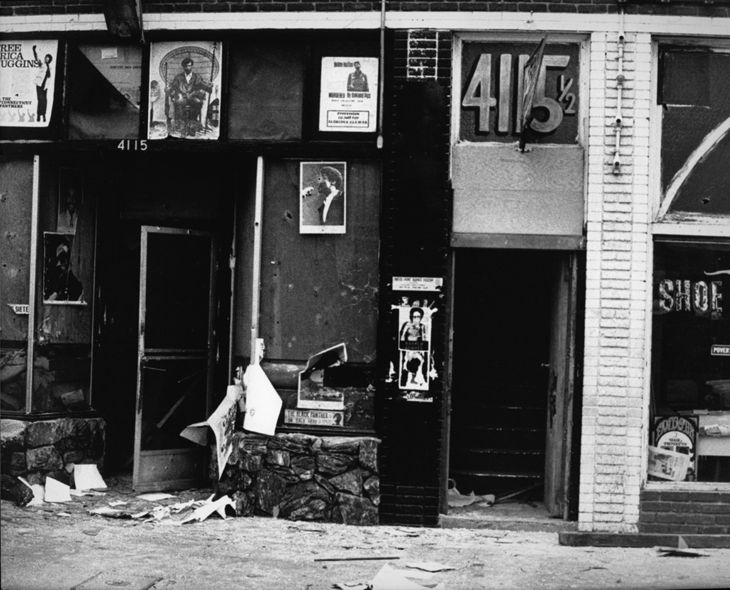
In France, a group that would go on trigger its own riots, the Situationists, wrote an article in response to the Watts uprising, praising it to the sky, and as they explained, the economic and psychological distance between blacks and whites enables blacks to see white consumers for what they are, and their justified contempt for whites develops into a contempt for passive consumers in general. The whites who reject this role have no chance unless they link their struggle more and more to that of the blacks, uncovering its most fundamental implications and supporting them all the way. These words were written in 1965, and by 1968, they were simple common sense to the French students who nearly toppled the French state that wild May.
1968 was a momentous year, and thousands of young hippies were busy reading the works of R. Buckminster Fuller, the designer of the geodesic dome, which many hippies were also building out in their hippie communes. As they read and built, their hero Bucky was freely ranting about how Sam [Rodia] is the first sculptor I know of in history to think in terms of tension and compression, using more than just a form which sculptors have been using for a very long time.
Not only did Bucky petition the National Endowment of the Arts on behalf of the CSRTW and the Watts Towers Art Center, but the face of Sabato Rodia was hidden in the cover of the Beatles album Sgt. Pepper’s Lonely Hearts Club Band, proving how far his reputation had spread across the world. And yet, somehow, amid all of this, no one seemed to know that Sabato Rodia was an anarchist, and it’s likely he told someone the truth and they just didn’t listen. If anything, the truth of his tales might have only registered to the children, the ones who grew up into the Watts of 1965.
XI: The Second Watts Transmission
The Watts Towers Art Center became a cultural mecca in the decades that followed, and every year a festival was held, attracting big names such as Bob Marley. Sabato’s transmitter just kept on humming, holding together the glowing core of an entire community. No matter how dark it got through the 1970s and 1980s, the Center continued onward with its mission, with the City now providing it funding, knowing it was the only way to save face. The children who attended the first summer programs at the center were now in their mid-thirties, and somehow things were bleaker in the spring of 1992 when the cops who nearly killed Rodney King were let free.
While the Watts Uprising of 1965 had been mostly contained there, what happened in April of 1992 was massive in comparison. After years of being pitted against each other selling CIA crack, the gangs briefly united to wage war on the system, and tens of thousands went wild with them, a righteous uprising aimed at a wretched system of death. Not only did Watts explode with fire, looting, and gunshots, but nearly every part of central Los Angeles, and if those rioters would have got their way, Hollywood and Downtown would have been sacked. That’s why national guard troops were called out, just as in Watts, and by May 1 the uprising had ended, but the message was heard.
One person who wanted to keep the dream alive was Tupac Shakur, and he went straight to Watts with something called Thug Life, a code of conduct thought up with his step-brother Morpeme and his uncle Mutulu Shakur. After the riot truce, Tupac wanted people in Watts to stop killing each over the CIA product, and so he helped facilitate a truce in Watts among the rival gangs, one that likely saved many lives. For this reason and many others, Tupac was hated by the government, but he only amped up his efforts, building a movement of militant, anti-police, pro-rebellion hip-hop artists that would spread their messages across the US.
A whole new generation was born out of April 1992, and the system did everything it could to crush it before it spread, both physically and culturally. By 1996, Tupac had been assassinated, and the once militant 1990s mainstream hip-hop got far more capitalist and less liberatory after his murder, to say the least. The police-state that followed the attack of September 11, 2001 didn’t make anything easier for the forces of liberation, and it wasn’t until the police murder of Oscar Grant in Oakland on January 1, 2009 that yet another generation rediscovered what it is to fight back against the system.
Between 2009 and 2020, the uprisings jumped from city to city across the US, mostly in response to the police murdering people, especially Black people, and after George Floyd was killed on camera for everyone to see, the entire country rose up for days, including Los Angeles. Unlike the uprisings of 1965 and 1992, the 2020 uprising in Los Angeles didn’t affect Black neighborhoods, it went straight into Downtown, straight into Hollywood, straight into Santa Monica, and it marked a shift in what would happen if the state kept killing with impunity.
For days, the entire country saw the momentary collapse of the racist, capitalist order, and while it didn’t stay collapsed for long, everyone knows what it looks like now. Just as Tupac once dreamed of, countless gangs put their conflicts on pause during the 2020 uprising to loot and pillage the collapsing order, and since then, this pattern has only increased. Riots and looting are now the de facto response against state terror, and while the gangs might still fight over territory, countless unaffiliated are looting and pillaging as they see fit, a pattern that is also increasing. Like the anarchist Buenaventura Durruti once said, we are not the least afraid of ruins, and as Sabato Rodia showed the world, a lot of beauty can come from ruins.
As you have seen above, Sabato Rodia most certainly hit his first wife Luccia, just as he inflicted trauma on his children from them hearing and seeing years of this abuse. Like many anarchist men of his time, Sabato couldn’t live true to his principles when it came to his family, he could only do so outside the family, something Ersilia Cavedagni had once criticized in general. We are not Christians, nor are we God, and so we are in no position to talk about redemption, but if such a thing did exist, it might look like a man living alone, hurting no one, and building something of such monumental beauty that it would inspire dreams of freedom in everyone who glimpsed its heavenly structure, transmitting only light from its three radiant towers.
